If you want to skip directly to the next part, then just hit
Part II
Introduction
This is an abridged description of a trip to Sabah in June 2011. The intention is just to give a firsthand personal experience of how I traveled to and around that place.
This time I booked in advance not only the flight but also the first night accommodation in Kota Kinabalu because of my late arrival.
How to get from Berlin (or Frankfurt or Manila) to Kota Kinabalu
There are many ways to get there. It all depends on whether Sabah is the main destination for the whole trip or part of an itinerary.
For me it was just a short hop from Manila to Kota Kinabalu with the
Cebu Pacific Airline.
I booked the trip online. My roundtrip fare was 3330 PHP, that's around 54 Euro. The airport tax in Manila for an international flight was another 750 PHP, i.e. 12 Euro. Except for Vietnam no other country charges an extra airport tax to my knowledge.
If you come from Germany, then look up the internet for cheap flights. Since Sabah belongs to Malaysia there are flights from Kuala Lumpur with the national carrier Malaysia Airlines and the cheap flight carrier Air Asia.
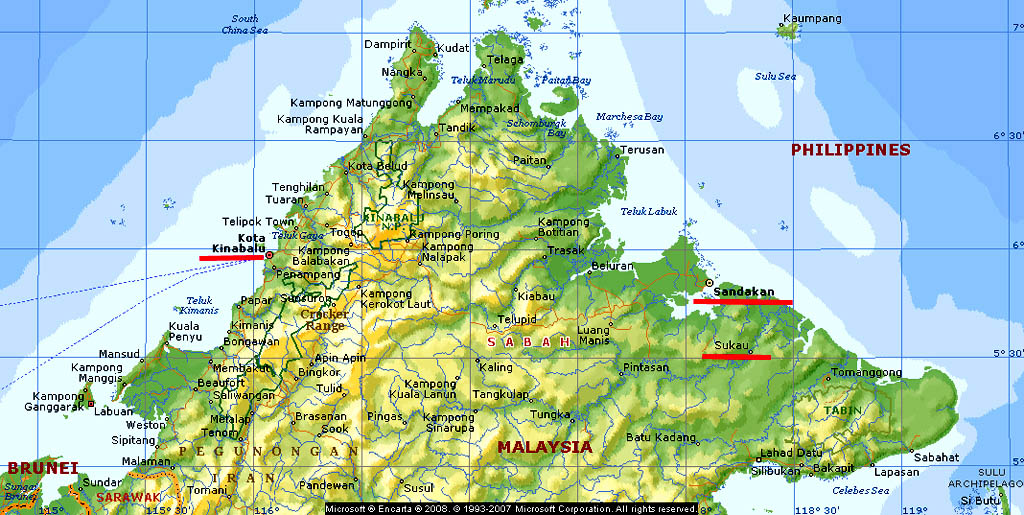
Arrival in Kota Kinabalu
After a 1 hour and 50 minutes flight,
I arrived at the Kota Kinabalu Airport, terminal 2, at 19:45. At the immigration counter I did get a visa for 90 days stamped into my passport for free. Malaysia is one of the least restrictive country in Asia to travel to.
I changed 100 Euro at the Maybank in the airport hall and received 429 ringgit. Later on when I withdrew cash with my Visa Card at the Maybank or HSBC, I did get 4.33 and 4.40 ringgit for 1 Euro. No extra charge like in Thailand if you use a foreign Credit Card.
The following prices are stated in Euro using the average exchange rate of 4.35 ringgit for one Euro.
From the airport you can take a bus if you are travelling on a shoestring. But I took a taxi for 6.90 Euro. It's a fixed price to anywhere in the city proper. The ticket has to be prepaid at the taxi stand in the airport hall.
Arriving at the Hotel
After a short ride of around 15 minutes the taxi dropped me off at the back entrance of the
Masada Backpacker
No. 9, 1st floor, Lalan Masjid Lama
Bandaran Berjaya
88000 Kota Kinabalu
Sabah, East Malaysia
Tel.: 6-088-238494
Email: masadabackpacker@gmail.com
Website: www.masadabackpacker.com
|
which I booked one week in advance through
www.hostelbookers.com.
The Private Double Room (no attached bathroom, though) did cost 18.60 Euro per night. Only a 10% deposit had to be paid in advance but no service charge.
Actually, I paid the price for two, because they don't have single rooms. You can make it cheaper if you share the double room with somebody else or stay in the dormitory. The self-service breakfast with coffee, tea, juice, toast, butter, jam, cornflakes and milk was included all the same.
I could have stayed in a hotel actually not that much more expensive (as I later did), but I still like the backpacker atmosphere: meeting many other travelers and exchanging information. The staff is also very knowledgeable about how and where to go. Guides can be hired for a reasonable price, especially if you join other travelers.
But I only stayed one night, because I missed my Chinese friends next day and then decided to get to my relatives, the apes, as fast as possible. But before I went to bed I had to eat. I strolled around in the streets and found a big place: the evening food stalls at the Sedco Square.
I wasn't fond of "My Place" with European Cuisine but more so having a seafood dinner from one of the many stalls around. Many life fish and crustaceans to choose from. You may think it must be cheap, but just the contrary. The bigger the more expensive per 100g. So I chose little prawns (grilled with garlic) for 4 Euro and mixed veggies and rice for 3 Euro. Half a liter bottle of Stella Beer did cost 2.30 Euro.
Click the small picture to get it enlarged

| Where to eat? Wolfgang's place?
|

| Better was one of the big seafood restaurants
|
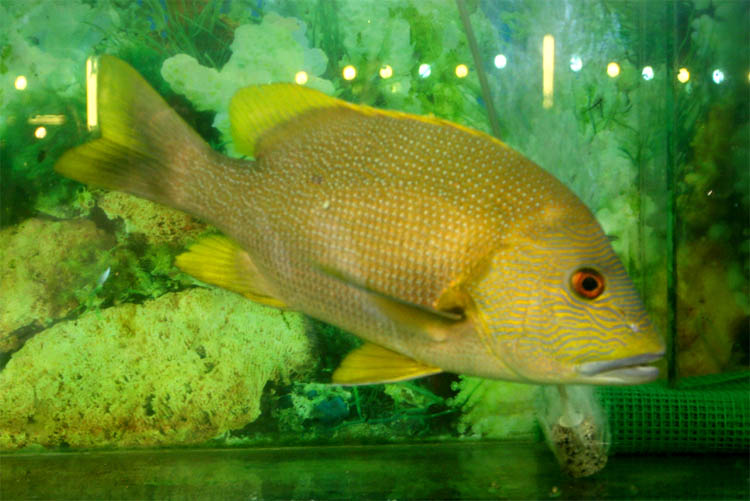
| Fish?
|
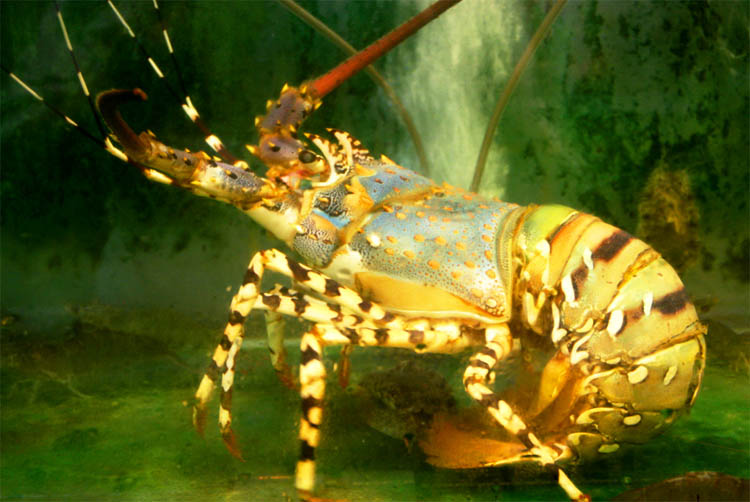
| Lobster?
|
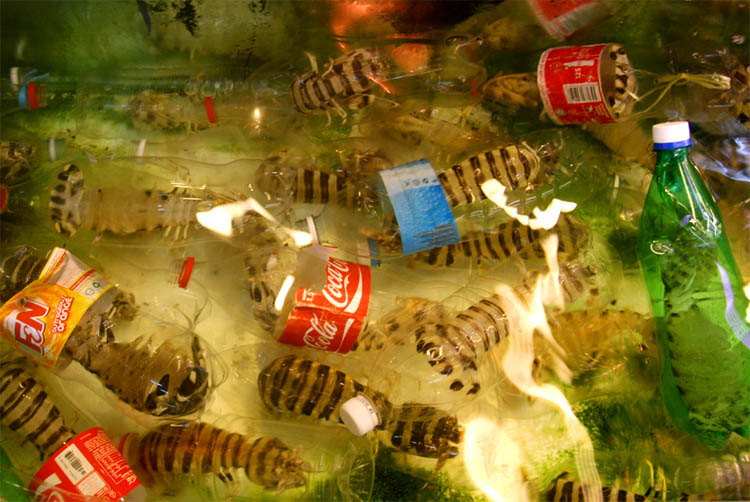
| Crustacean in a coke bottle?
|
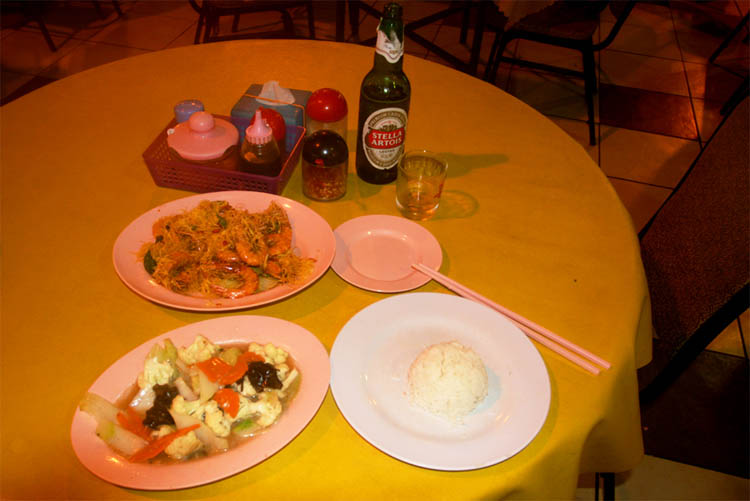
| Better: little grilled prawns with veggies
|
Getting to Sandakan
Next morning I tried to call my Chinese friends I stayed with 26 years ago. But to no avail. I went to their office, but it was closed. I know that they went to Kuala Lumpur but not when they will return. So I decided to leave Kota Kinabalu and try to contact them again upon my return.
The station where the buses are leaving to Sandakan was far out in the north: in Inanam. I took a taxi for 4.60 Euro to get there. The bus to Sandakan leaves every hour on the hour. I just did get there shortly before 10 a.m. but the bus was already full. I did get a seat on the next bus at 11 a.m. The ticket did cost 9.20 Euro.
While I was waiting I bought a SIM-card at a telephone shop for 2 Euro plus a pre-load for 11.50 Euro. Local and international calls were really cheap, so that I couldn't use up my balance until I left the country.
The ride to Sandakan took seven hours including one stopover at a road side restaurant. We passed through a nice countryside and came close to the base of Mount Kinabalu I climbed 26 years ago. Shortly after 6 p.m. we arrived at the Long Distance Bus Terminal in Sandakan.
From there I had to take a taxi for 3.50 Euro to get to the Harbor Square. I chose that destination because I retrieved a backpacker hostel with the same name, the
Sandakan Harbour Square (B & B)
Block HS10, Lot 100
9000 Sandakan
Sabah, East Malaysia
Tel.: 6-089-676442
Email: admin@shsbnb.com
Website: www.shsbnb.com
|
from the internet, and that was right at the waterfront. The hostel was simple but: location, location, location. The double room with aircon and hot water and window did cost 10.30 Euro per night including a self-service breakfast.
The receptionist was a nice guy and very helpful. He offered me a deal for a day trip to the Sepilok Orang Utan Sanctuary and Labuk Bay Proboscis Monkey Sanctuary for 35 Euro. I could have taken the public bus (Batu 14) to Sepilok (20km from Sandakan) for less than 1 Euro, but Labuk Bay is farther away and no public bus is going there. And it was good deal because it also included more interesting sites to be visited.
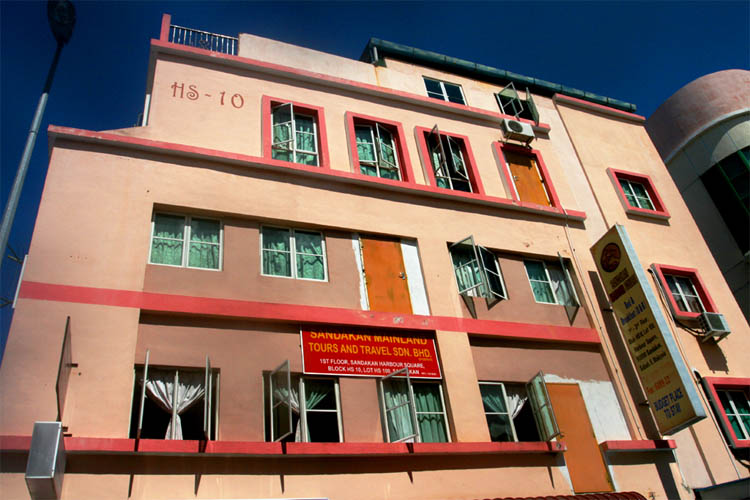
| My Backpacker Hostel
|
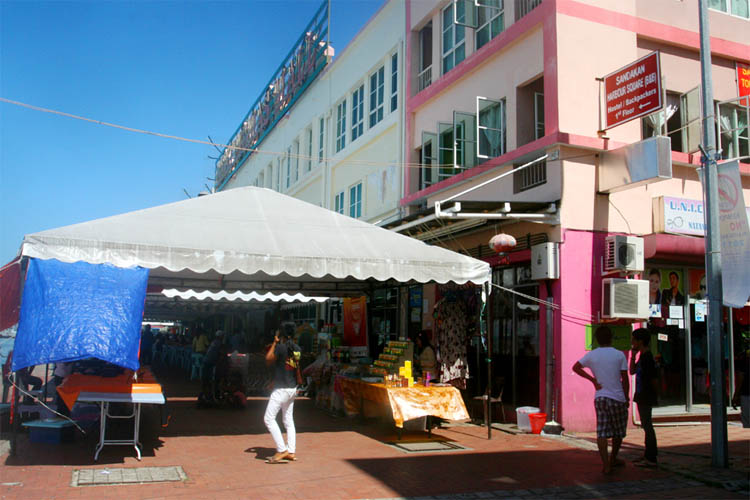
| Right at the waterfront
|
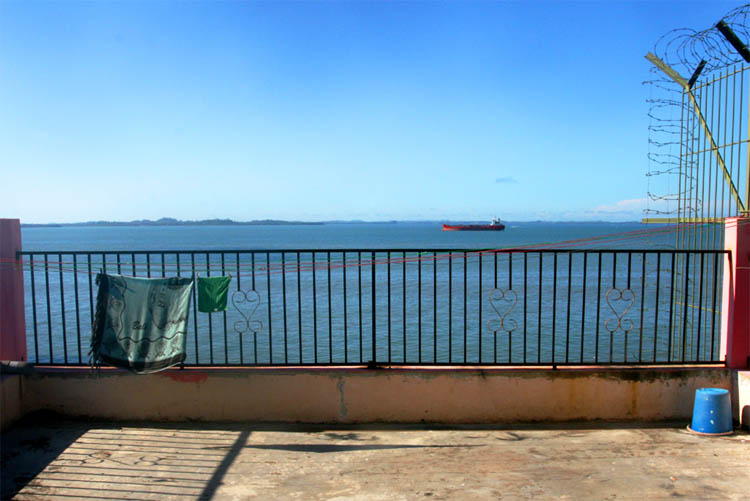
| View from the top to the sea
|
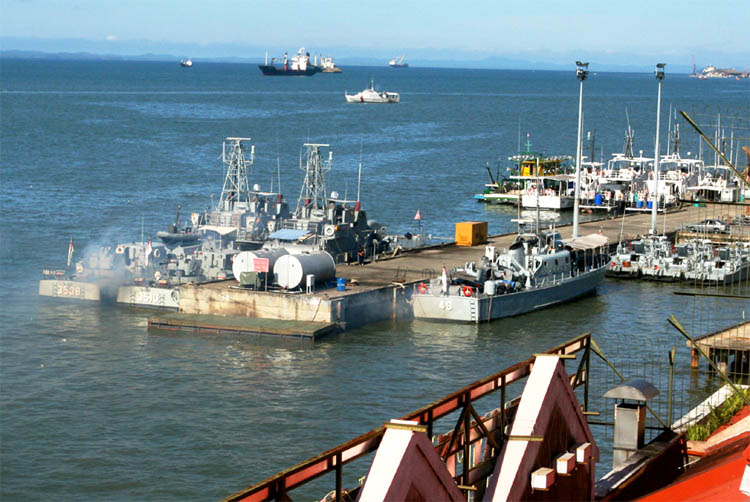
| and to the Naval Base harbor
|
The Sepilok Orang Utan Sanctuary
Next morning I was picked up by a friend of my receptionist guy and his van. At first I was wondering whether he would drive me alone for that kind of money. But he toured around and picked up other tourists from various hotels (and from various countries: Singapore, New Zealand, Australia and Slovenia). Since I was first I had the front seat.
At around 9:30 a.m. we arrived just in time for the feeding time at the Sepilok Orang Utan Sanctuary. The entrance fee was 6.90 Euro and the camera ticket another 2.30 Euro. Following is a description in a brochure of the Sabah Tourism Board:
"The sanctuary started in 1964 for rehabilitation of orphaned baby orang utans from logging-sites, plantations and illegal hunting, returning them to the wilds as soon as they're ready. More than 4,500 hectares of virgin jungle were designated as forest reserve and sanctuary for these charming creatures."
Actually, this is the least mankind can do as some kind of reparations. If human beings would not have cut down the forests for lumber or oilpalm plantations or hunted them illegally, then there wouldn't be any orphaned orang utans, one of our closest relatives. 96,4 % of their genes are similar to our human genes. We should have one more the same of their genes, which is their love for peace. Also, the indigenous people put them close to human beings by naming them "Man of the Forest", that's the translation of "Orang Utan".
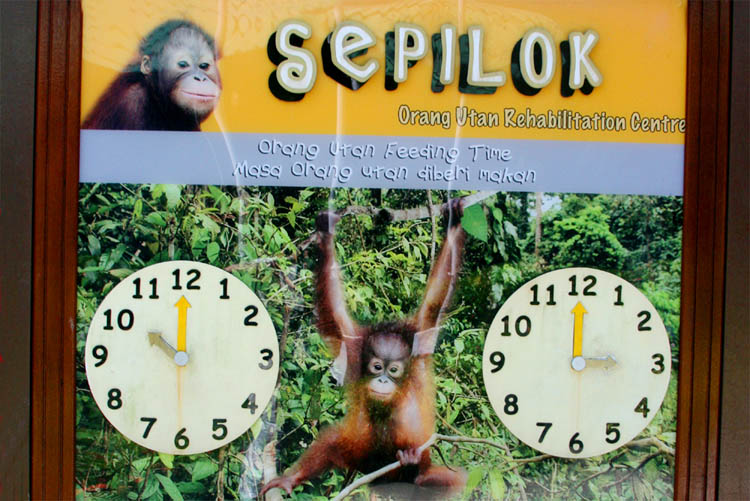
| Sepiloc. Feeding time just in time
|

| in the Orang Utan Sanctuary
|
There are not only little orang utans, but also older ones who became so fond of human beings that they don't want to return to the wilds. Other semi-wild orang utans come to the Sanctuary twice daily from the forest for feedings of milk and fruits. Now enjoy looking at them.

| Where are the Orang Utans?
|
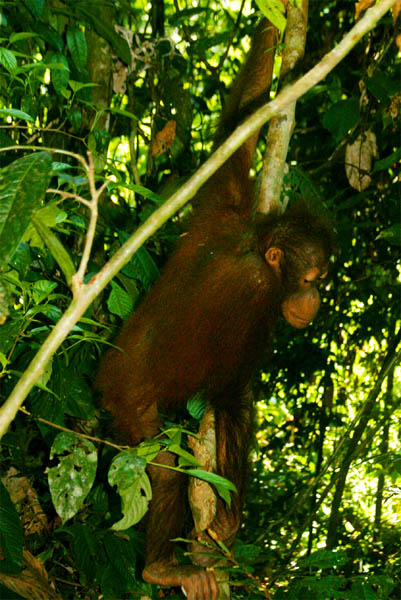
| Here they are. My first encounter
|

| Do you recognize me as your cousin?
|
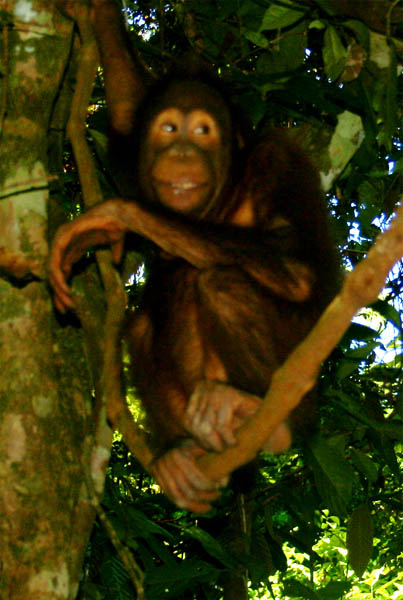
| But he doesn't seem to know me
|
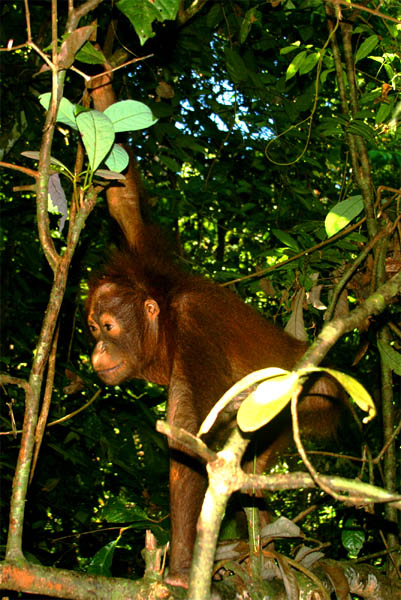
| They are not afraid
|
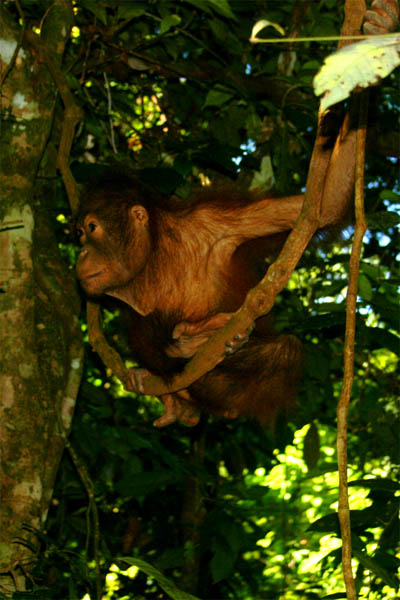
| of human beings
|
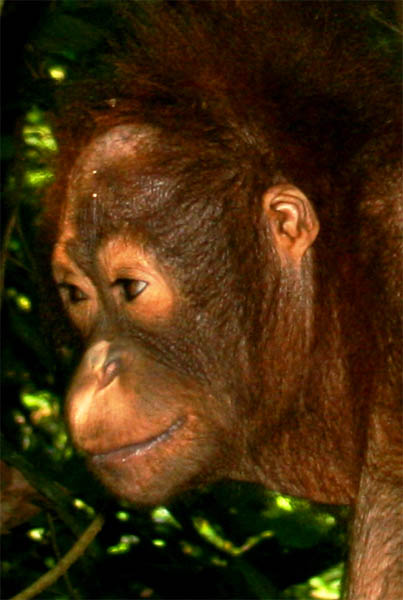
| He looks intelligent
|
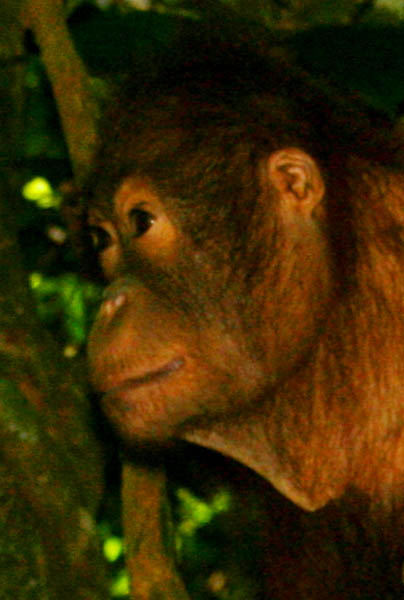
| but what is he thinking?
|
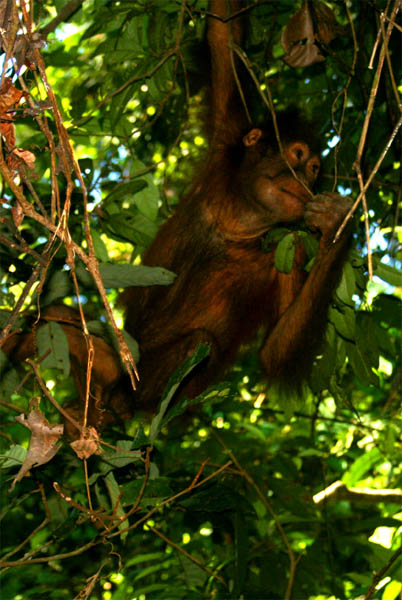
| Is breakfast being served?
|
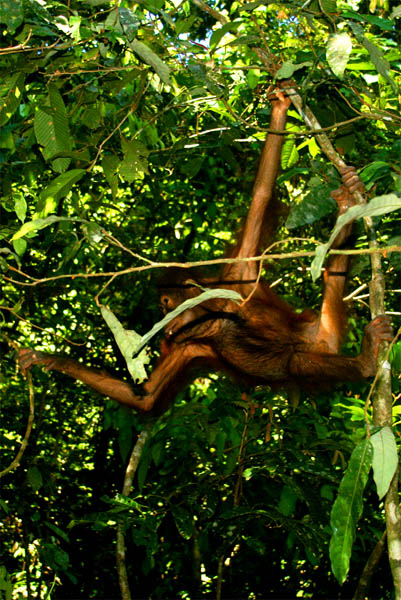
| Yes? Ok, then let's go
|

| Swinging from branch to branch may be dangerous
|
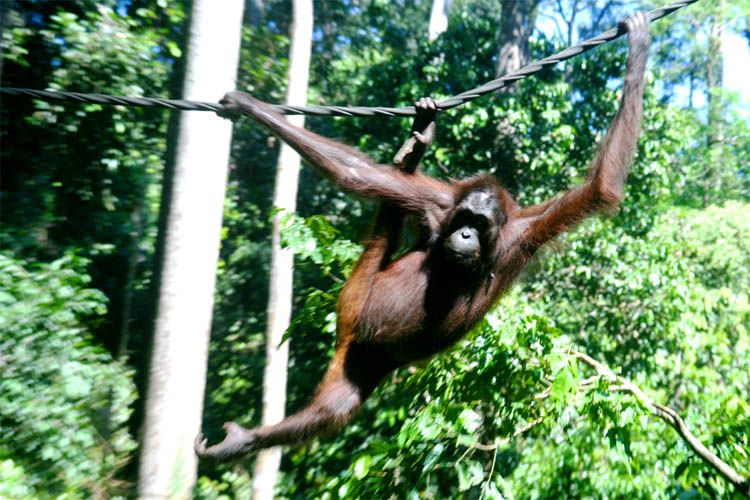
| It's more safe to use the rope
|
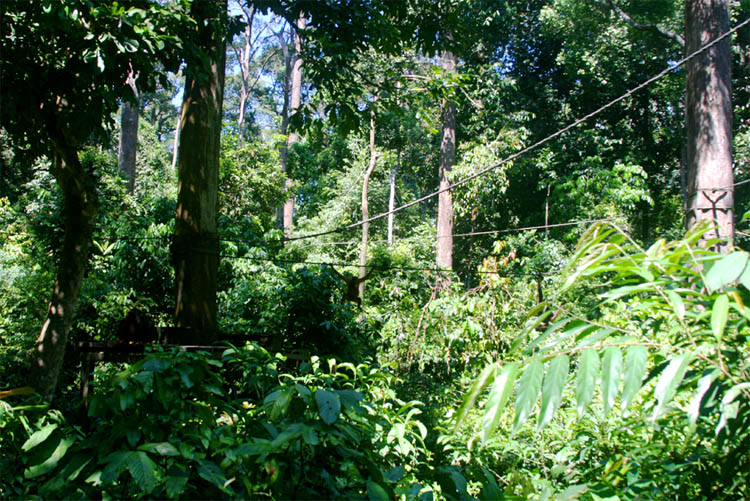
| The ropes are leading to the feeding platform
|
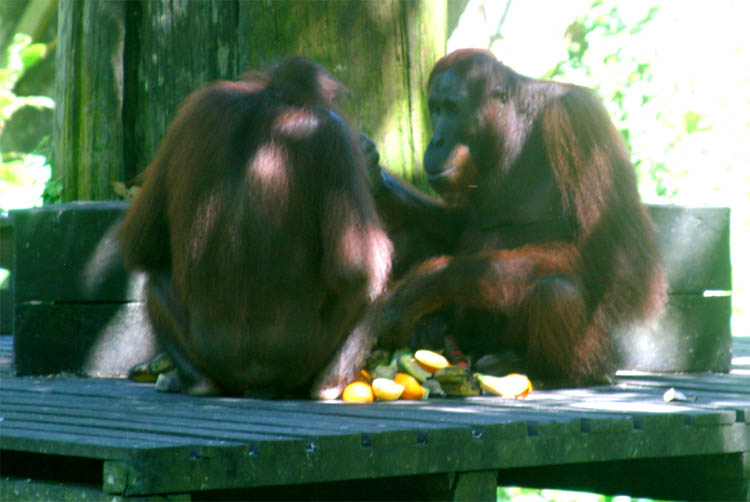
| Where the alpha guys are already there
|
Labuk Bay Proboscis Monkey Sanctuary
Next stop another sanctuary. Here are the proboscis monkeys being taken care of. The name proboscis means large long nose and that's exactly what these monkeys have got in their face. They look funny to us human beings but not funny to the female proboscis monkey. Just the opposite. The longer the nose of a male the sexier he is and the more wives he has.
It seemed that the monkeys need more protection and care than the orang utans, because the entrance fee was double: 13.80 Euro, though, the ticket for taking photos was the same with 2.30 Euro.
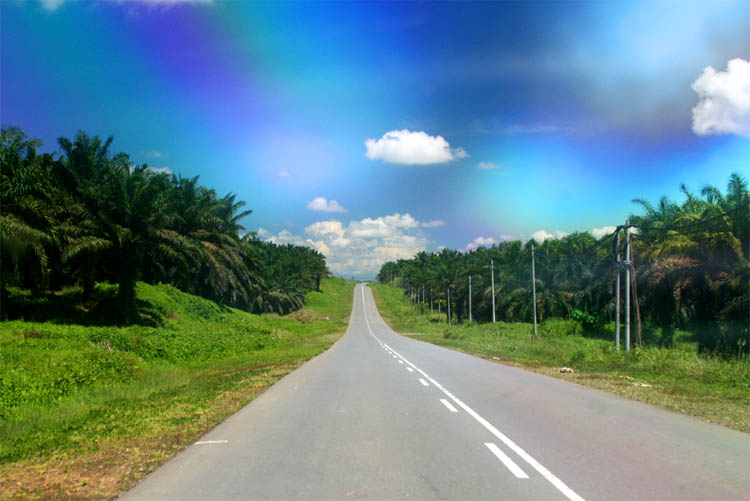
| The road to
|
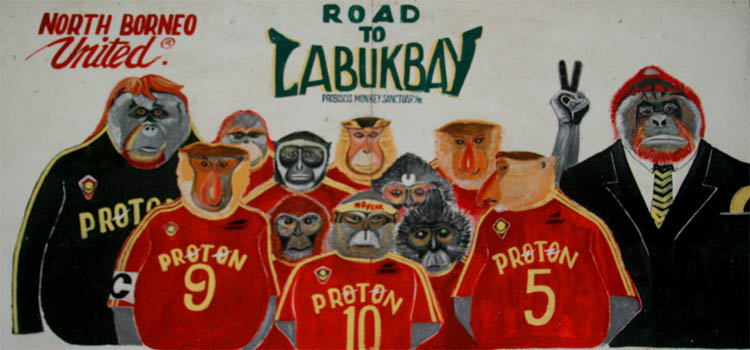
| Labuk Bay
|

| There they are
|

| The proboscis monkeys
|

| With the funny
|
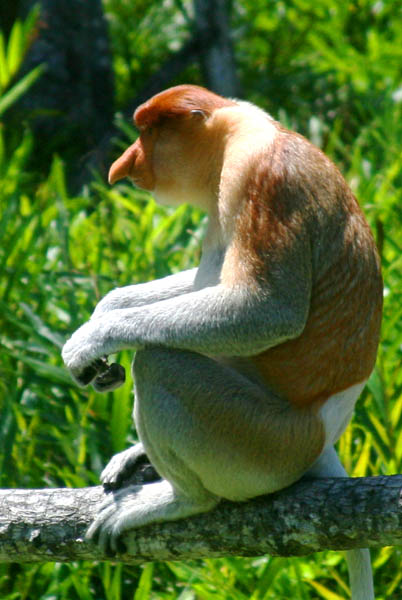
| long nose
|
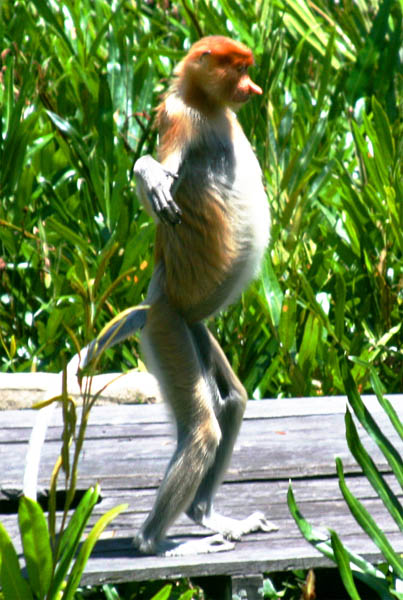
| With a round pot belly
|

| and the long thick tail
|
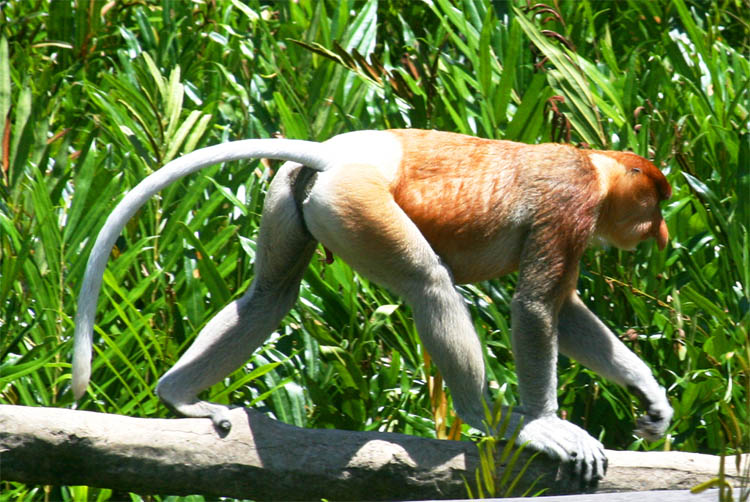
| With a short stiffy penis
|
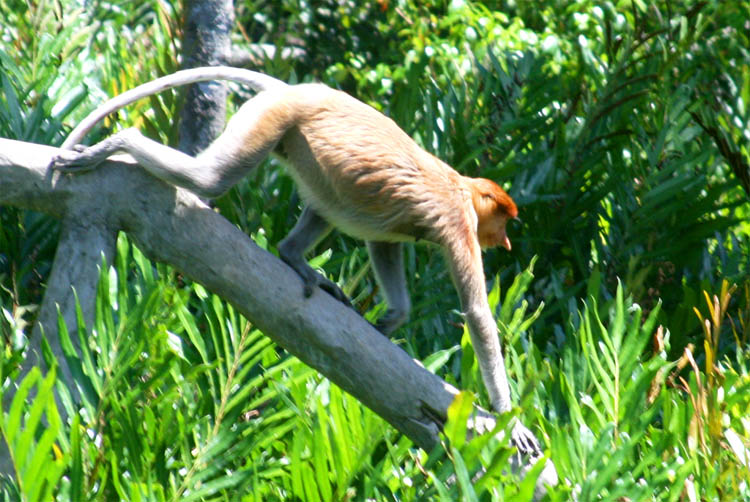
| but long fingered feet
|
What is the difference between a monkey and an ape, like the orang utan? Monkeys have tails, apes and human beings have not. But monkeys, apes and human beings all have a nose. And many human beings have a nose between an ape, short and flat, and a proboscis monkey, long and big. You find small and flat noses in south East Asia and big long noses in Europe. The longest noses, according to the indigenous people in Sabah, belong to the Dutch. That is the reason, why the proboscis monkeys are also called "Dutch Man" by the locals.
Though, there is no relationship, as far as the size is concerned, between the nose and the penis, neither that of a man from Netherland nor the "Dutch Man". It may be just the opposite, as you can see on the photo above, even if you enlarge it. And it seemed to be always ready for action. No wonder, if you have up to 30 pretty wives at your disposal.
The nose of a female is smaller than that of a male and may have opposite attraction: the smaller, the prettier.
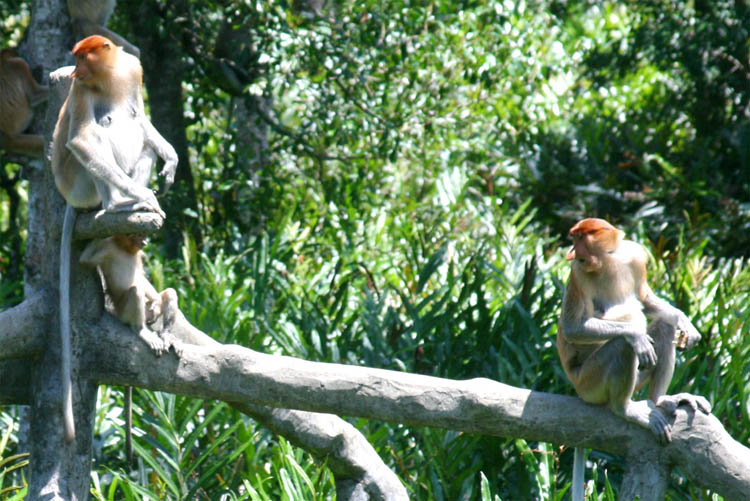
| The females with a baby
|
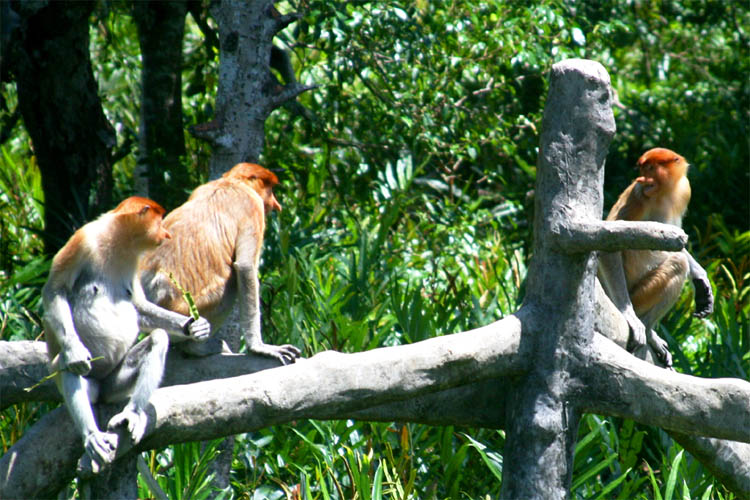
| seem to have a women's chat
|
There were not only proboscis monkeys but also silver leaf monkeys, another endangered species. They were not as shy as the proboscis monkeys and came very close to us onto the viewing platform.

| The silver leaf monkeys
|
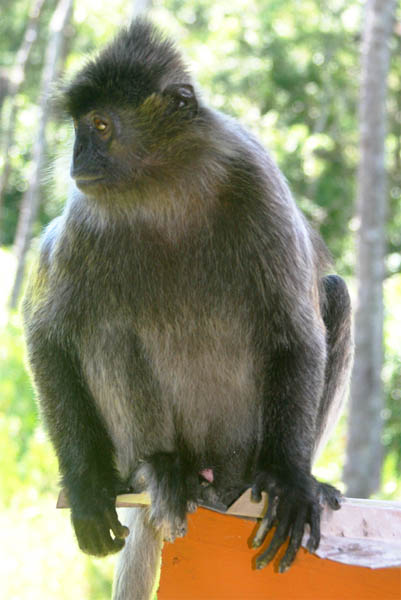
| look aggressive, but aren't
|
Also some nice birds were around, undisturbed by the monkeys, because they are no prey and could easily fly away. The egret can be found almost everywhere around the world. The hornbill, however, is endemic in tropical Africa and Asia. There are many different types of hornbills in many colors, shapes and sizes. What wonderful and beautiful birds.
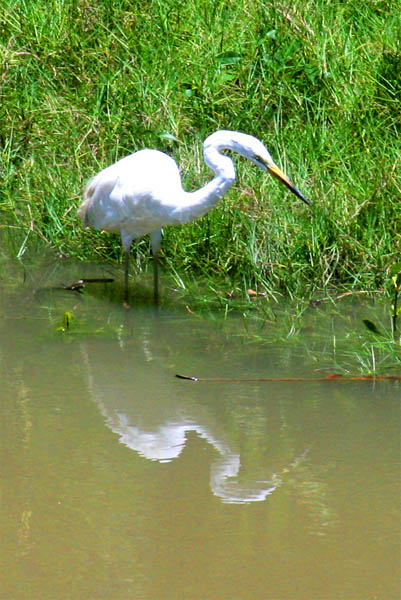
| A white egret
|
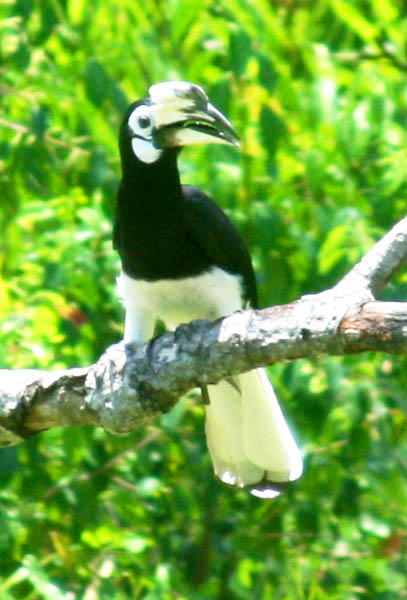
| A black and white hornbill
|
There are still so many different species in Sabah. Some parts still have a well functioning diverse ecosystem: from the mammals in the forests to the amphibians to the swamps. We will see more in the waterway system later on.

| A little squirrel
|
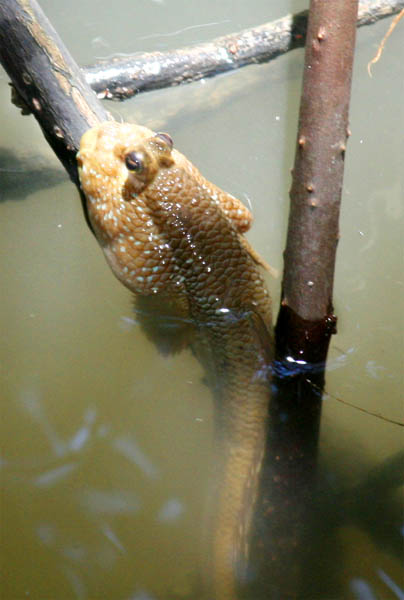
| A giant tadpole
|
However, mankind still disturbs the ecosystem by cutting down forests in order to plant oil palms for profit. In East Sabah I passed through oil palm plantations mile after mile and as far as you could see. Malaysia is with almost 50% the biggest palm oil producer in the world. With the oil palm seeds you can earn more money than with coconuts. I should have accepted the offer by my Chinese friend to invest in oil palms 26 years ago.
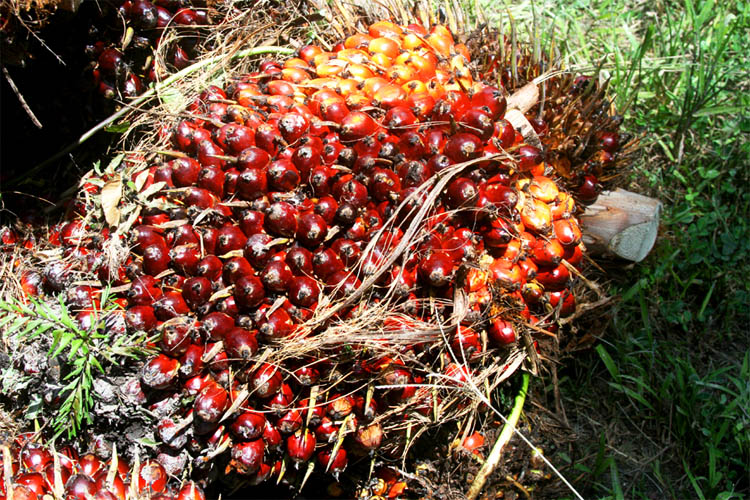
| What kind of fruit is this?
|
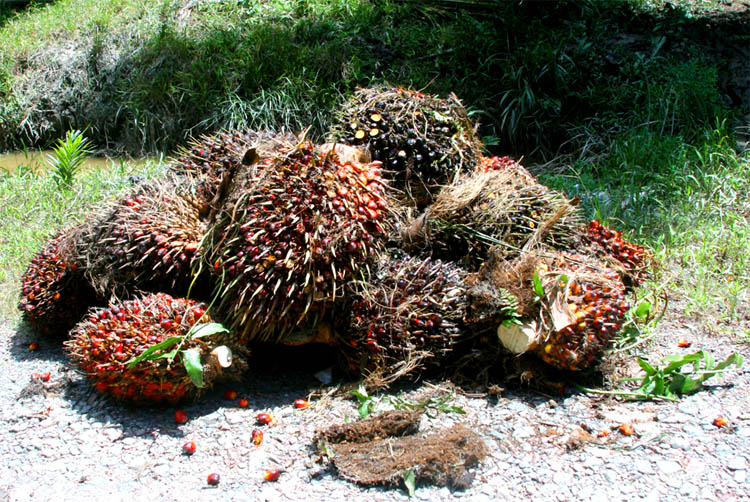
| They are oil palm seeds
|
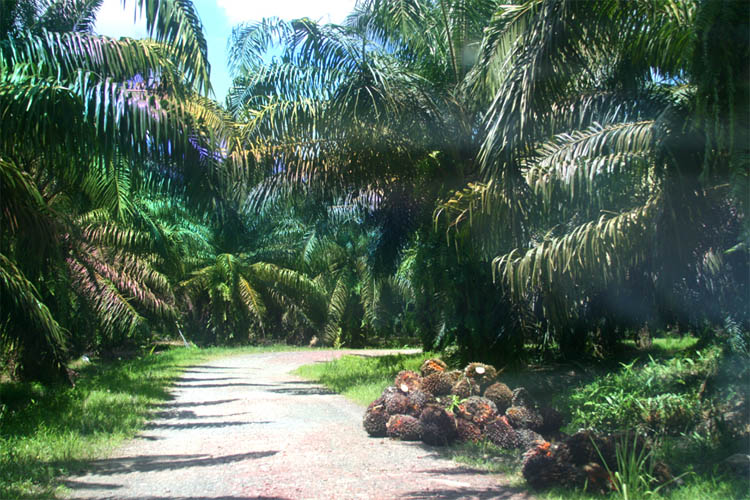
| They are just being harvested
|

| On the left: new oil palms have been planted
|
The Sandakan Memorial
Next stop is an example of the misery which had to endure not only to the orang utans and proboscis monkeys but also human beings: the British and Australian soldiers imprisoned by the Japanese during World War II.
Read the description from the plaque about the atrocities committed by the Japanese. The last line reads: In late 1943 there were about 2500 prisoners at Sandakan. At the end of the war only 6 were still alive - and they survived because they escaped.
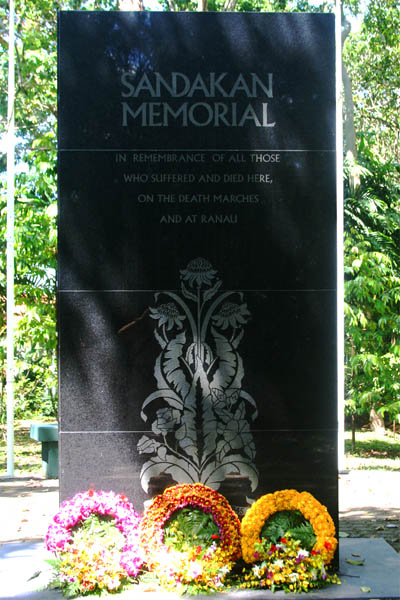
| Now a very sad place: The Sandakan Memorial
|

| Where British and Australian POWs suffered and died
|
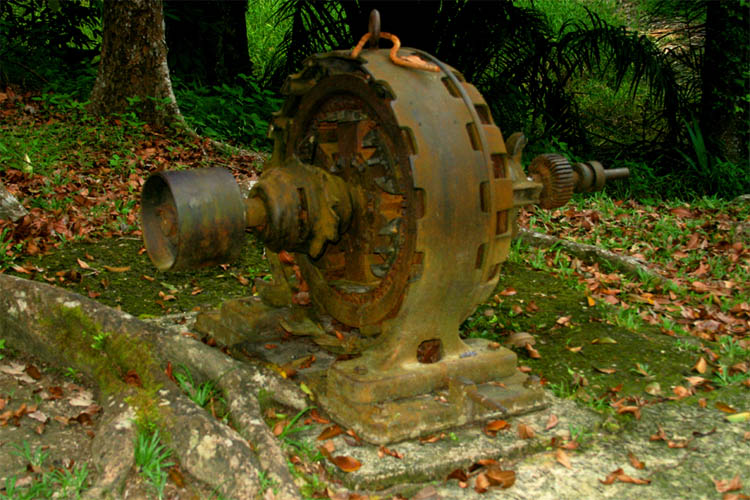
| Tools used by the POWs
|
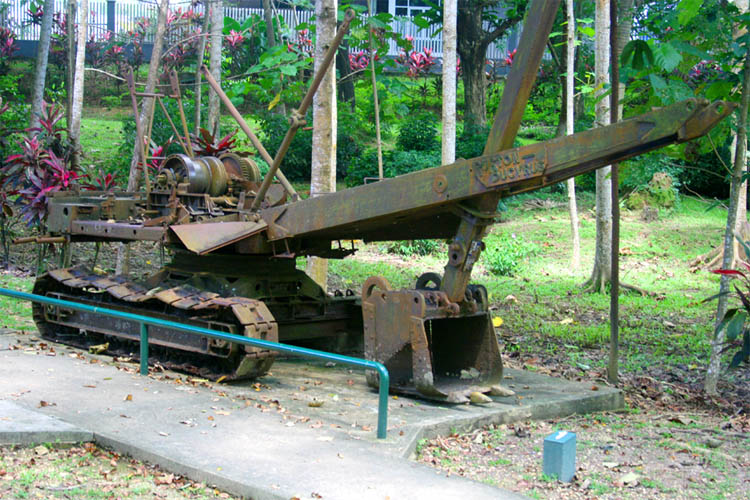
| to build an airport for the Japanese
|
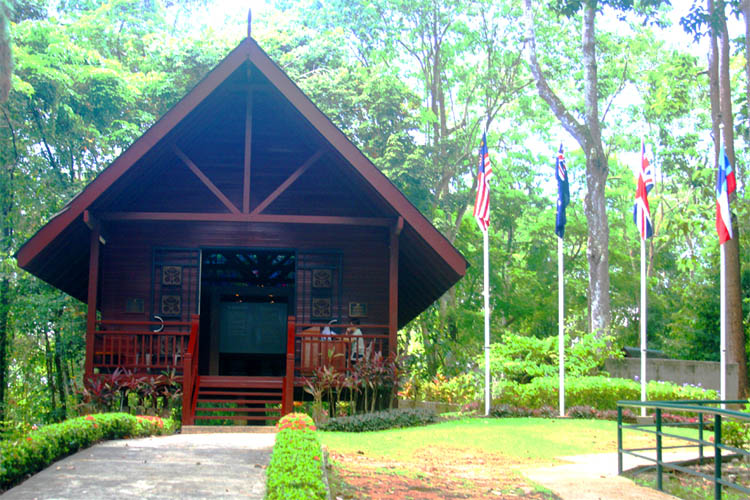
| A museum in the center of the former POW camp
|
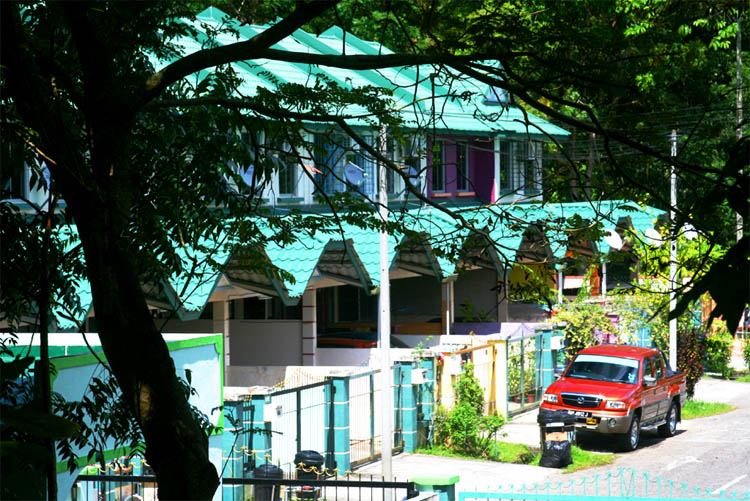
| A new houses complex next to the former POW camp
|
The Puu Jih Shih Buddhist Temple
After visiting the POW camp we worshiped Buddha at a Chinese temple and I wished enlightenment to all the good people who died during the war. It is said that the temple protects and brings good-health (and wealth, of course) to Sandakan and its people. I can use that too.

| The Chinese gate to heaven?
|
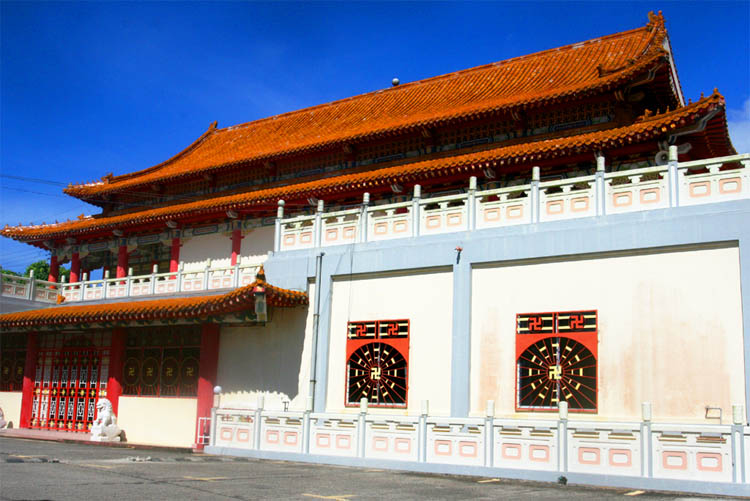
| A Chinese temple to worship Buddha
|

| Inside with rich decorations
|

| And Buddha in many appearances
|
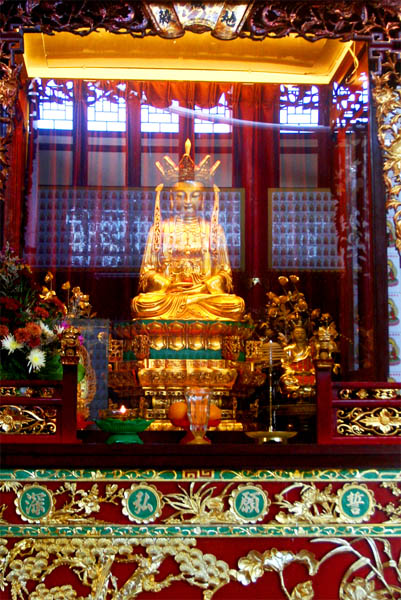
| One Buddha to the left
|
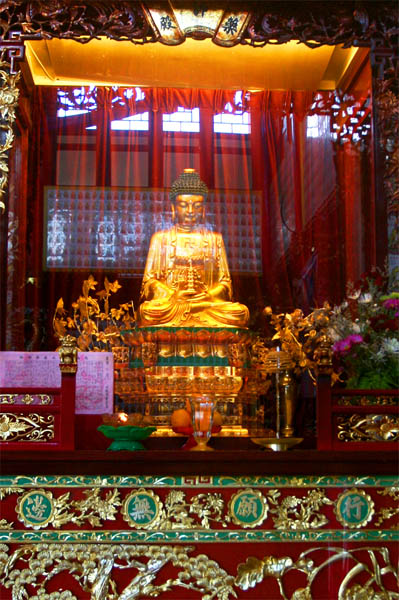
| Another to the right
|
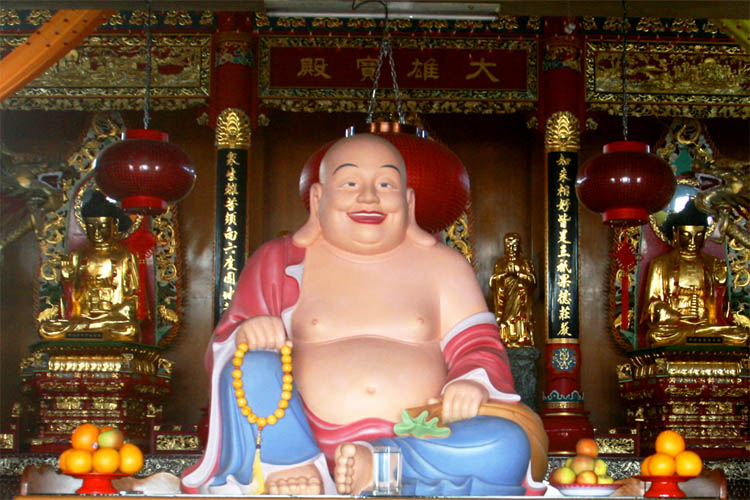
| Also the Happy Buddha is worshiped
|
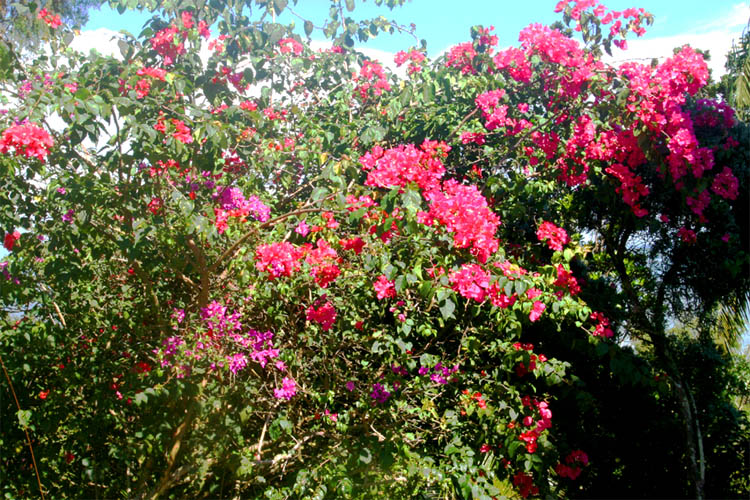
| I am rather happy to admire the nature
|
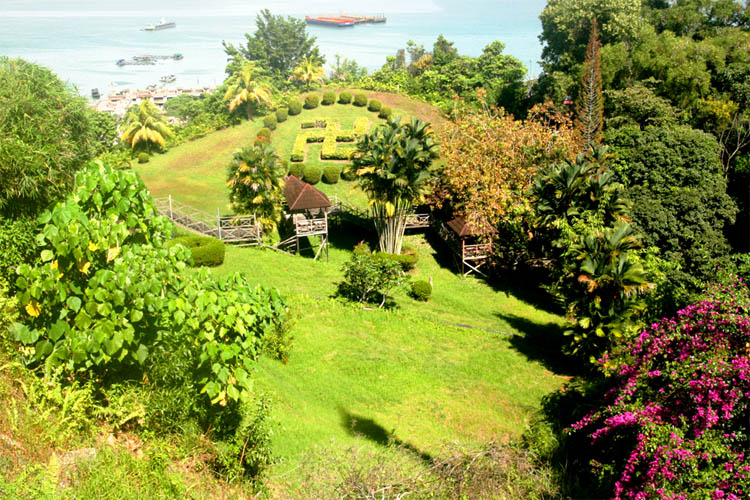
| With a beautiful view to the Chinese garden
|

| And an overall view to the city of Sandakan
|
Don't think that the Nazis did get hold of this place instead of the Japanese. This swastika is an old Chinese religious symbol with the four arms bend at right angles in a counterclockwise versus the Nazi clockwise direction.
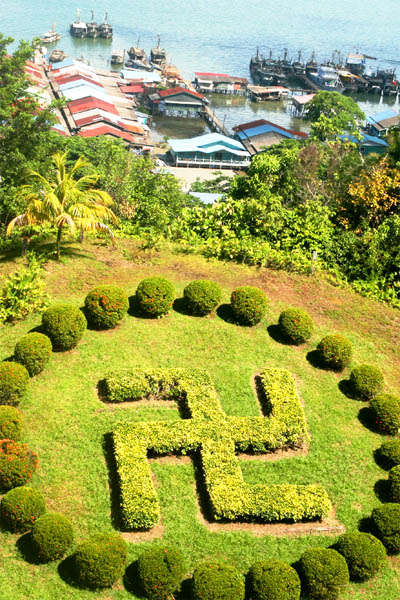
| A holy Chinese sign in the garden
|
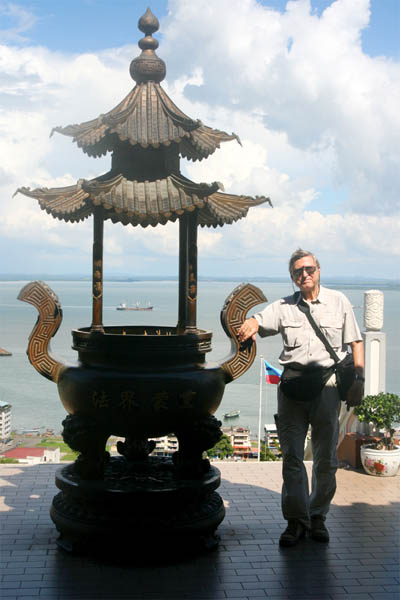
| And the obligatory incense amphora
|
The St. Michael & All Angels Church
This beautiful granite St. Michael & All Angels Church was built in 1893 and took 20 years to complete. This is one of the few Sandakan's pre-war buildings still standing. It looks inside as nice as the outside.
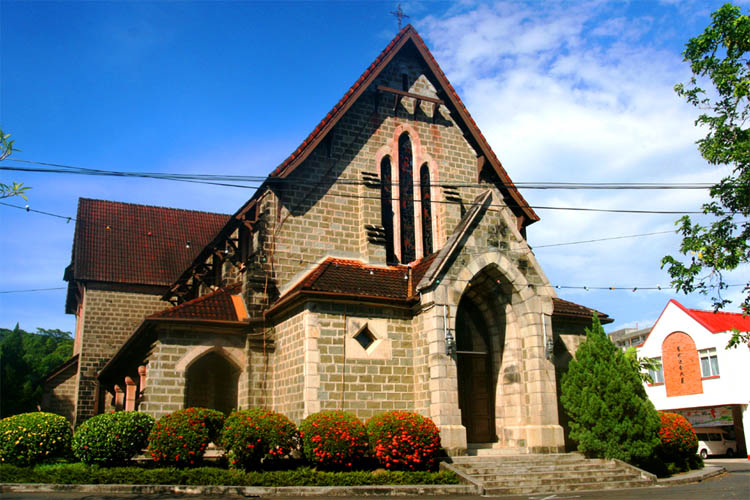
| The oldest church
|
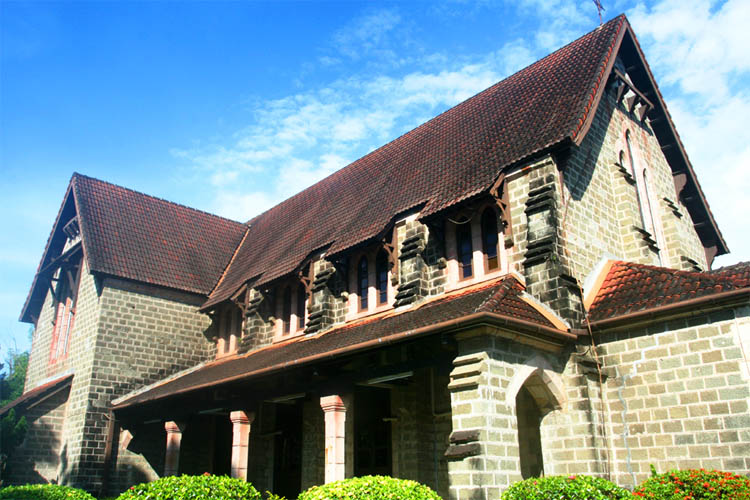
| in Sandakan
|
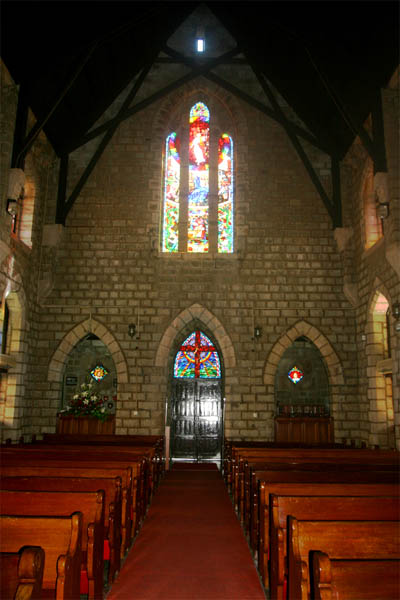
| The interior west side
|
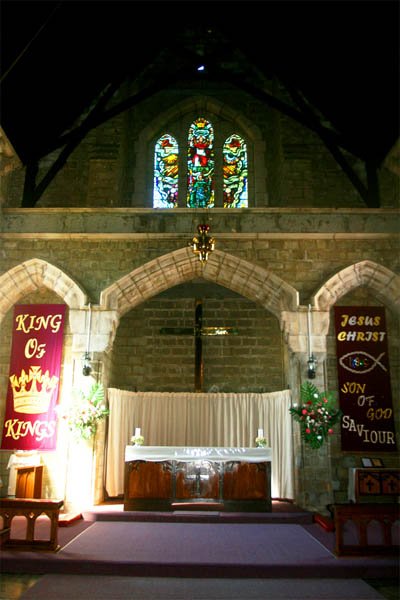
| The interior east side
|
But the beautiful windows of this church are the highlights. An extra brochure describes those "Friendship" windows on five pages. Here is the name of the artist: Philip Handel. These unique pieces of art may be the reason for the entrance fee of 3.50 Euro.
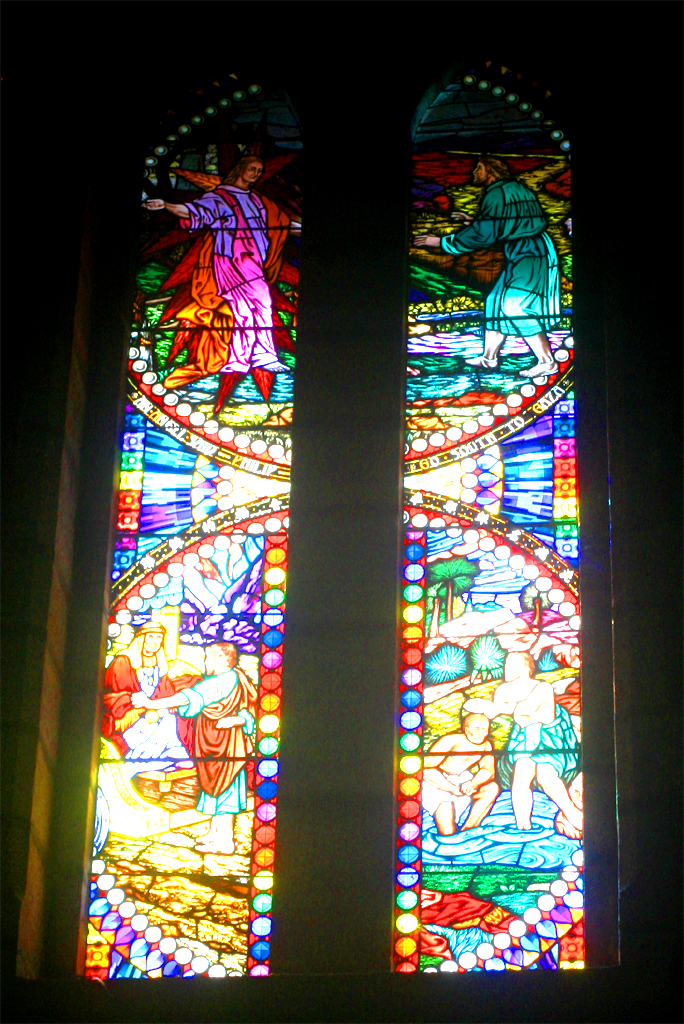
| The north friendship window
|
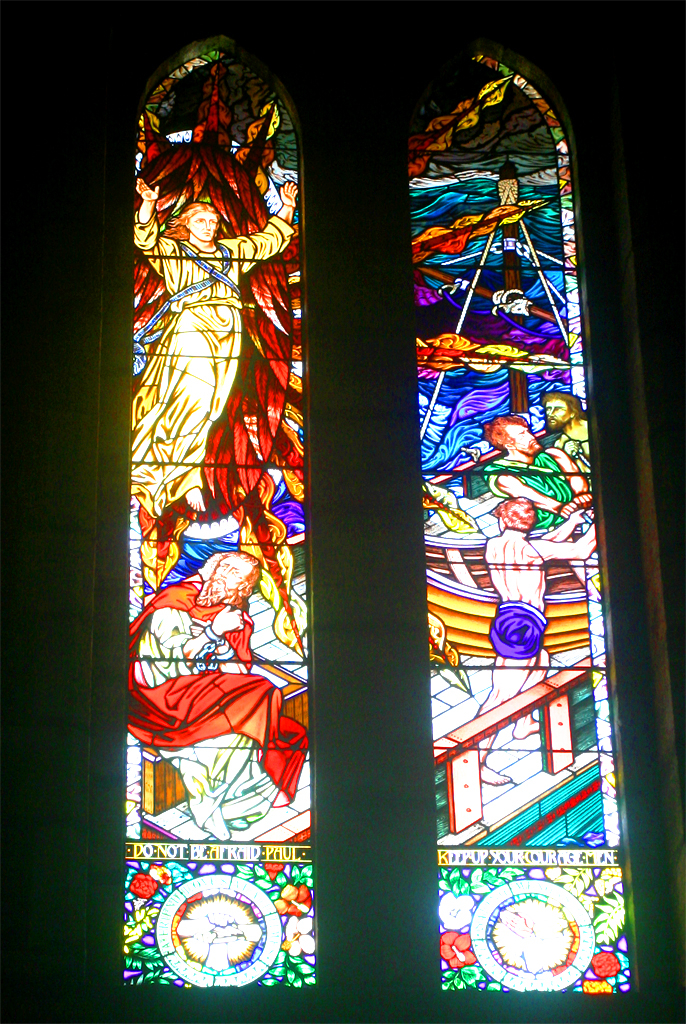
| The south friendship window
|
The Agnes Keith House
This house was once occupied by the famous writer Agnes Newton Keith (Land Below the Wind) from 1934 to 1952 with some interruption when it was destroyed during the war. The house was rebuilt in 1948 and a complete restoration took place in 2001. Because this was not old enough for me and it was not furnished with real antiques, I decided not to visit it for an entrance fee of 3.50 Euro.
Instead, I rather joined the group having a tea time treat (pot with Sabah tea with two original English Muffins with jam and whipped cream) for 4.80 Euro in a garden pavilion of the English Tea House with a beautiful view down to Sandakan town.

| The Agnes Tea House
|
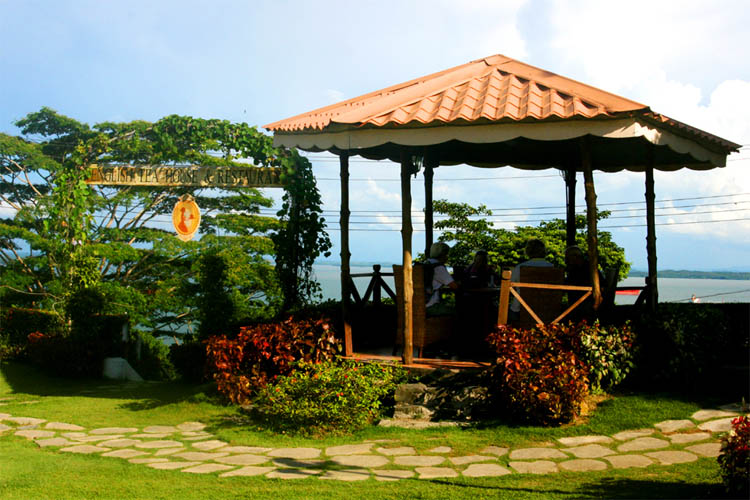
| with a nice view
|
Gomantong Caves
Next day another excursion. First stopover was the Gomantong Cave, a bird's nest cave. If it wouldn't have been part of the tour package I would have said "No go man, tong", because I was going only on bird's shit and almost slipped. The dirty rail couldn't be touched either. And I didn't see any bird's nest anyway, because it was too dark inside the cave (no guide with a lantern around). So it wasn't worth the entrance fee of 6.90 Euro.
Though, it is called "the best managed edible birds' nest cave in the world". "Harvesting" is twice a year and quite a dangerous operation. But it seems to be worth the effort. One kilo of bird's nest can earn up to 1,500 Euro. A bird's nest soup may cost between 20 and 80 Euro. I would not eat it at any price. Imagine, it is made with the saliva of the male swiftlet bird.
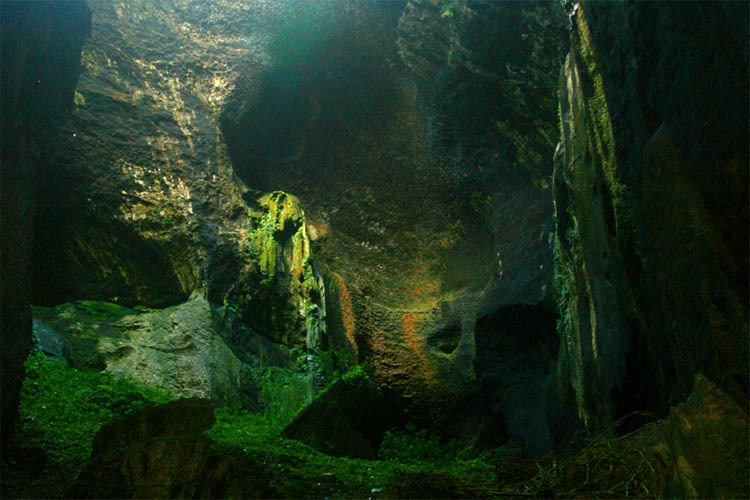
| Inside the birds nest cave
|
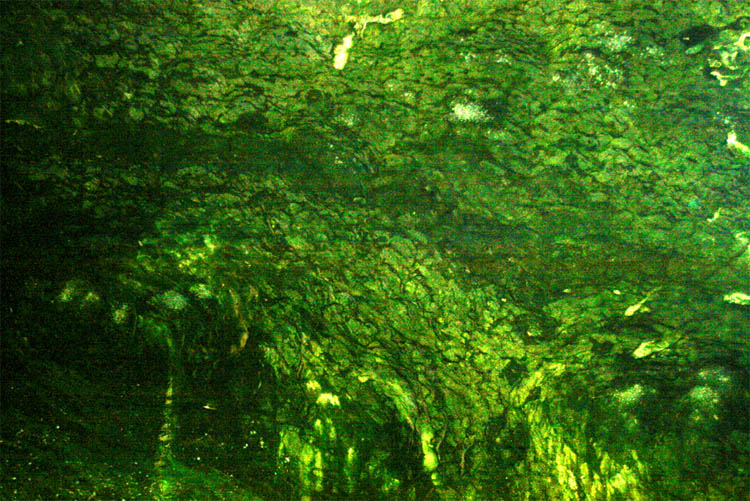
| but where are the bird's nest?
|
The Sukau Greenview B&B
The next stop offered the better part: staying at the Sukau Greenview B&B with one night accommodation, dinner, lunch and three Kinabatangan River cruises. And all that for a special price of 69 Euro including transport from and to Sandakan (three hours ride one way). Ask the receptionist at the Sandakan Harbour Square B & B for that special deal.

| Inside was my nest for the next night
|
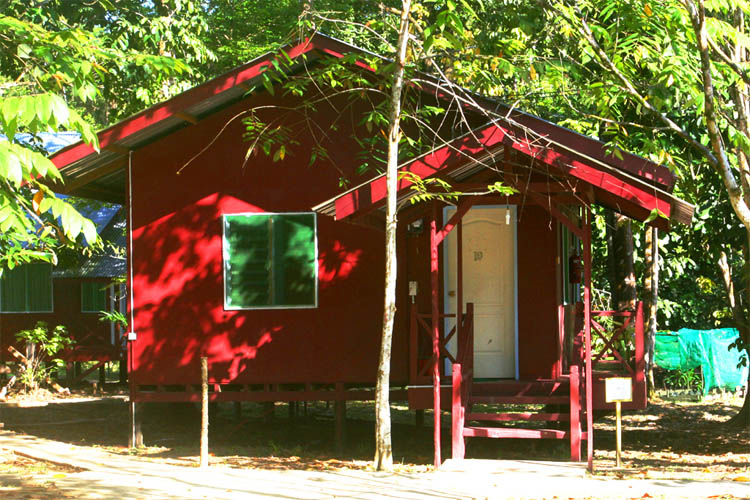
| A cottage beside for an Australian couple
|
Kinabatangan River Afternoon Cruise
Our group consisted of almost the same people of the day before: from Singapore, New Zealand, Australia, Slovenia and two singles from Austria and Spain. Right after we arrived we went altogether on the afternoon cruise. Now you also can accompany me by looking at the following picture.

| First afternoon river cruise
|

| but the sky doesn't look good
|
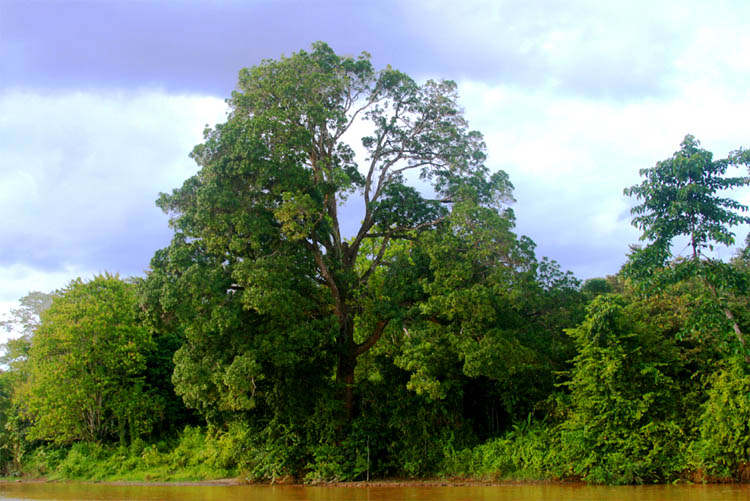
| Where are the animals?
|
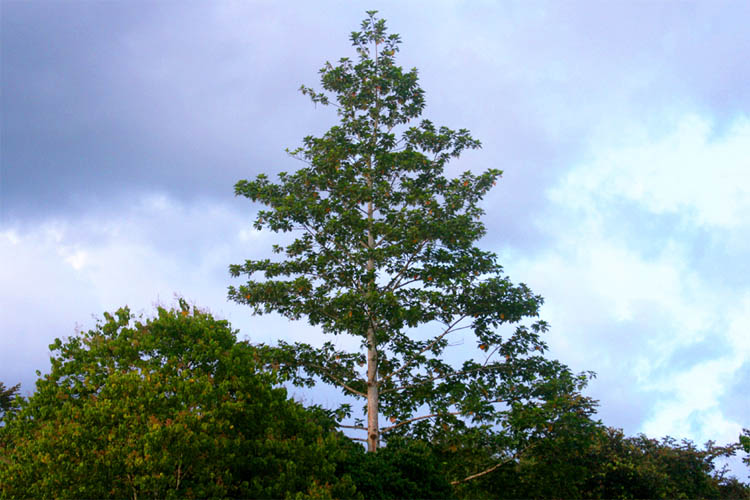
| I only see trees
|
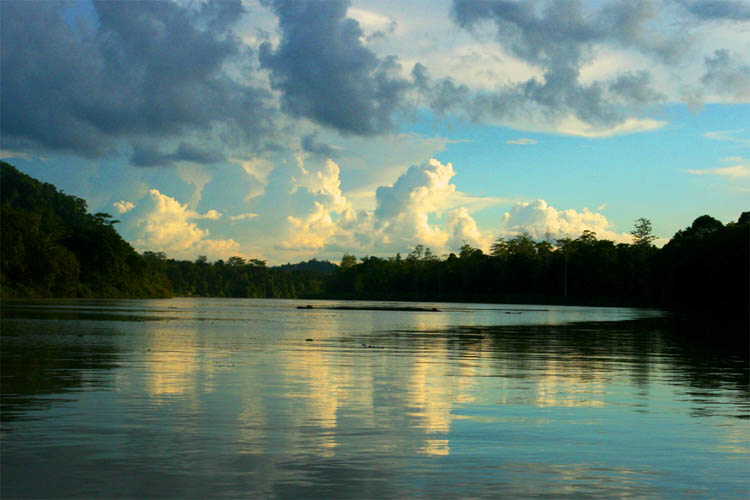
| Rainy clouds go away
|
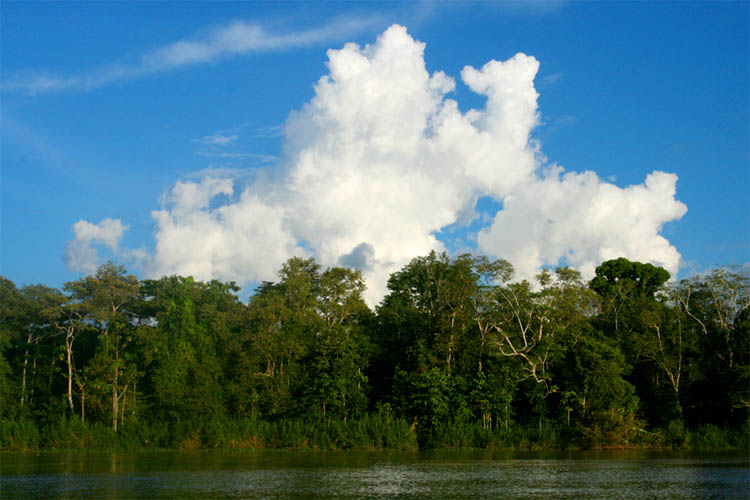
| and let the evening sun come through
|
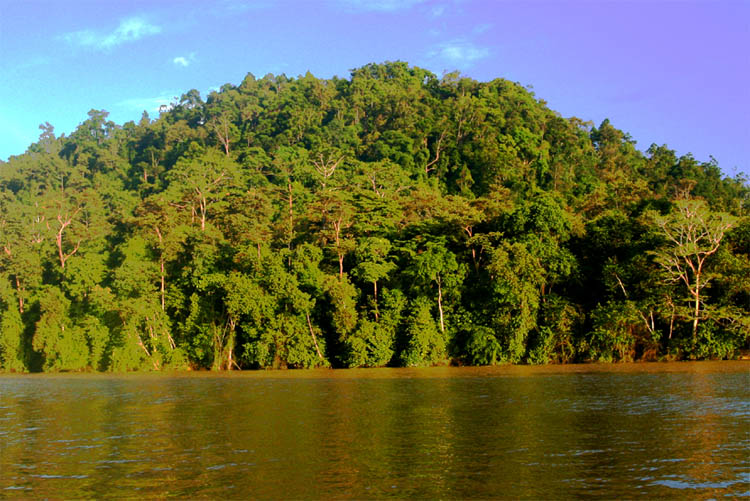
| Scanning the riverside
|
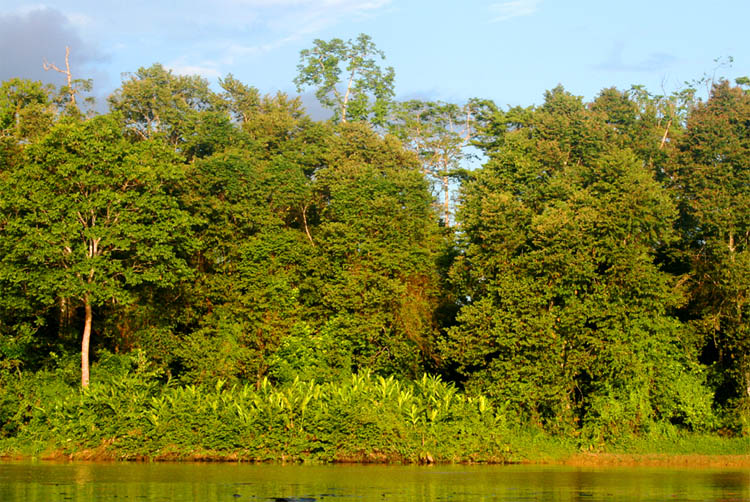
| Where are the monkeys?
|
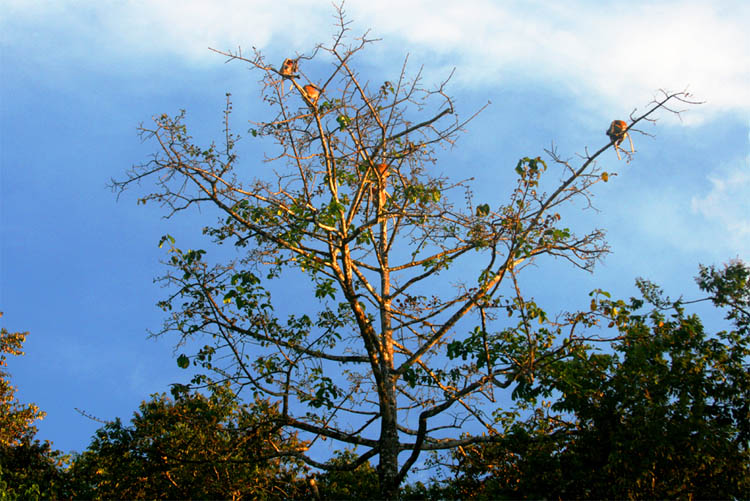
| There they are, wild probocsis monkeys
|

| Let's get closer to have a better look
|
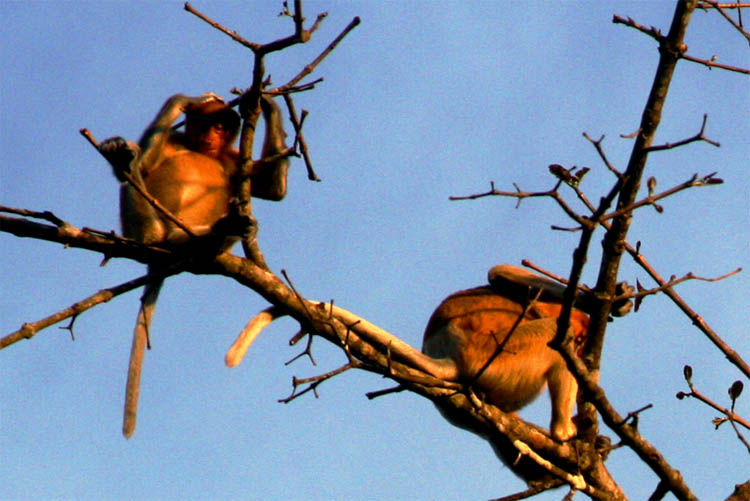
| We have already been spotted too
|
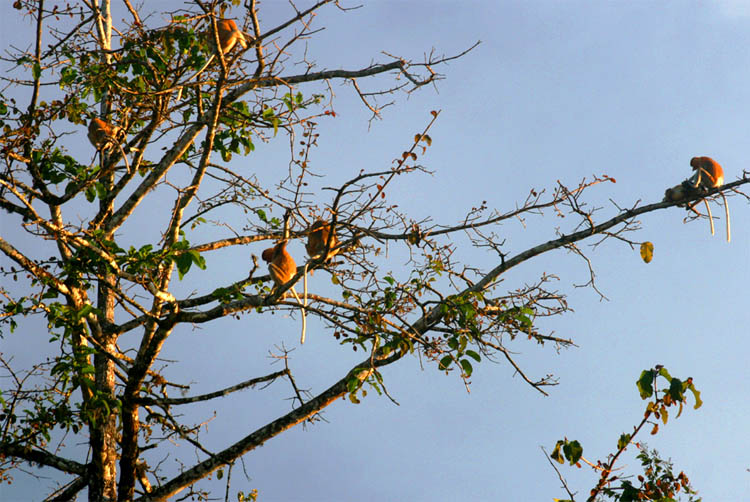
| But what's happening on the other branch
|
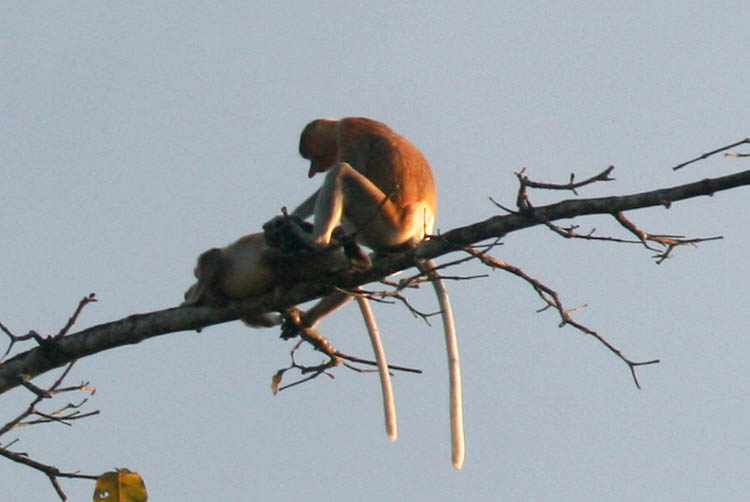
| First inspection
|

| then copulation?
|
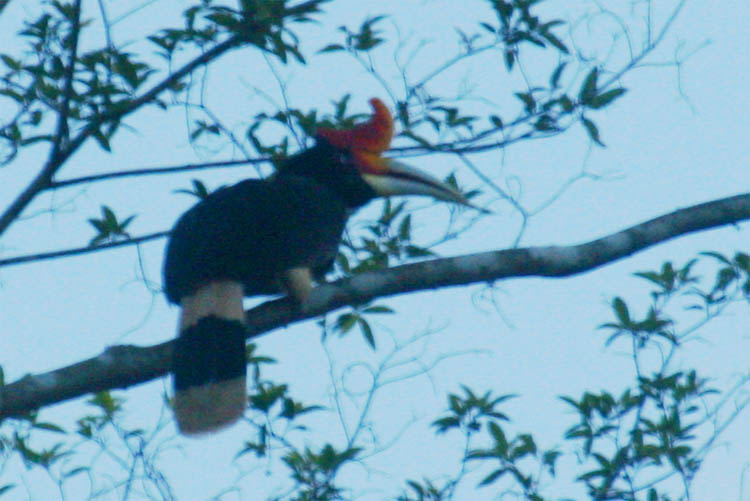
| A hornbill looks astound
|
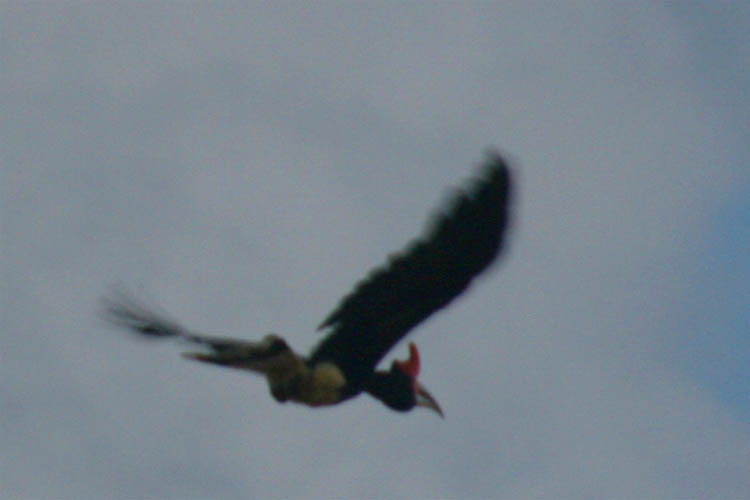
| Then it flies its round
|
Kinabatangan River Night Cruise
After the very good buffet dinner we had to embark on the river night cruise. All dark around us and no sound, except from some swiftlet birds. Our boatman and guide was very experienced to find the spots where the nocturnal animals are looking for prey... or were just sleeping.
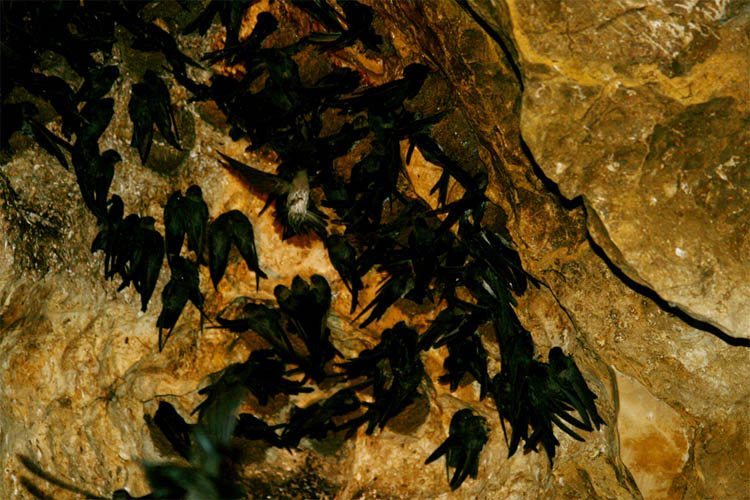
| Birds in a rocky niche
|
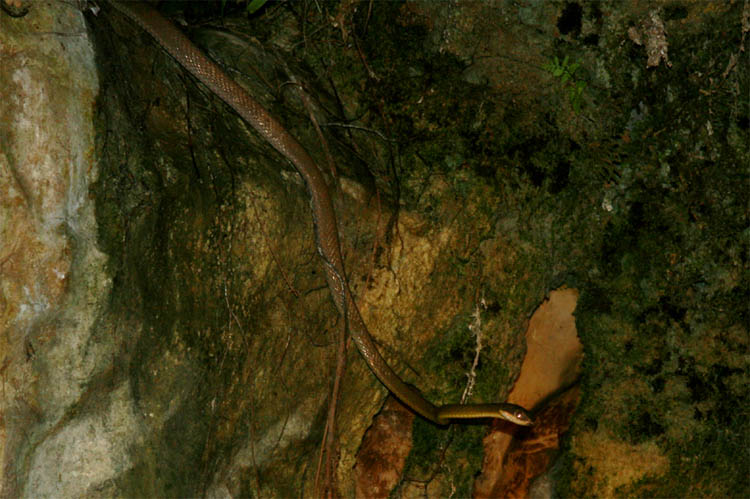
| A viper tries to reach
|
Though we had to be careful not become prey ourselves. Even if a viper cannot swallow a human being but it is able to kill one with its venom. A python is not venomous but may strangle you to death, though he would have also problems with you to digest.

| The head of a viper is small
|
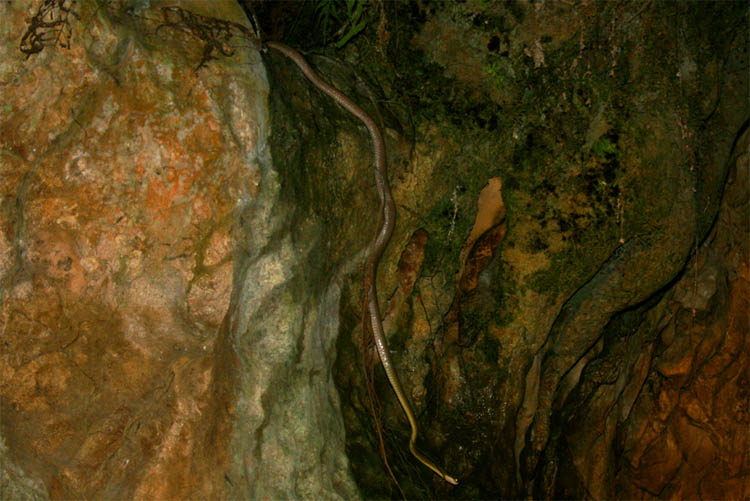
| but it is long and tall
|
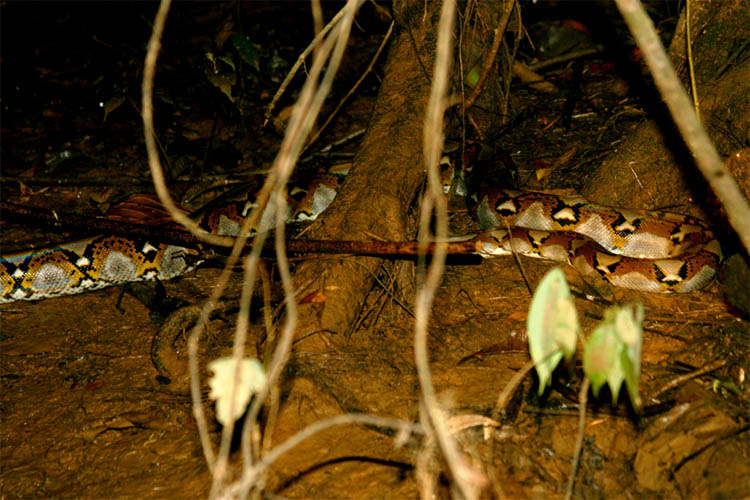
| A python also is looking for prey
|
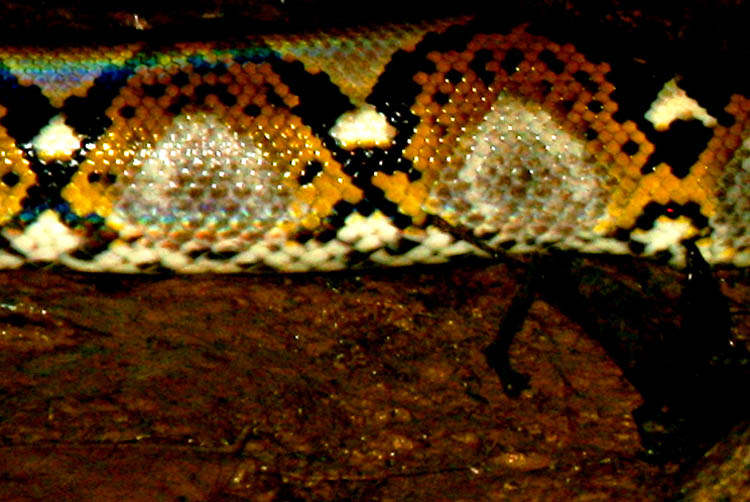
| look at this beautiful pattern
|
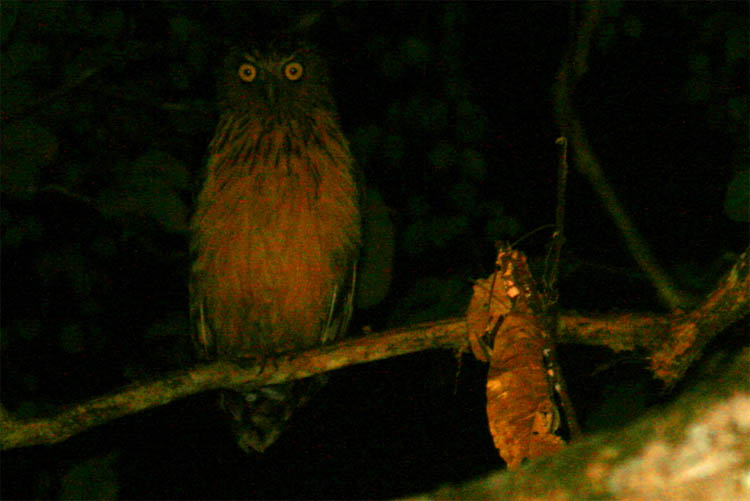
| The Buffy Fish Owl also looks for prey
|

| The kingfisher is just sleeping with an open eye
|
Kinabatangan River Morning Cruise
Early morning at 6 a.m. another cruise. First we are looking for awakening life. A monitor lizard already enjoys the warm morning sun. First time that I saw one on a tree. Now I also would have liked him to fall into the river. Maybe he will do that later, because he is also a very good swimmer.
Unfortunately, we did not see crocodiles, who are supposed to roam around in these waterways. Also small elephants, rhinoceros and wild oxen are still living in Sabah too, but they can only be found in another area a little more down south, the Tabin Wildlife Reserve.

| Scanning the forest next morning for wildlife again
|
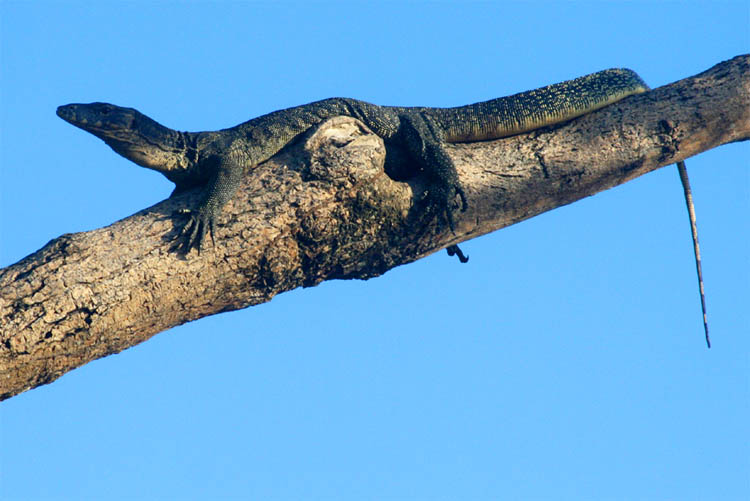
| A monitor lizard warms itself in the morning sun
|
Now let's enjoy our morning cruise here and now. This time we left the wide Kinabatangan stream and slowly entered small waterways in order to reach a lake, the Oxbow Lake, a bird's paradise.

| Probing a side arm of
|
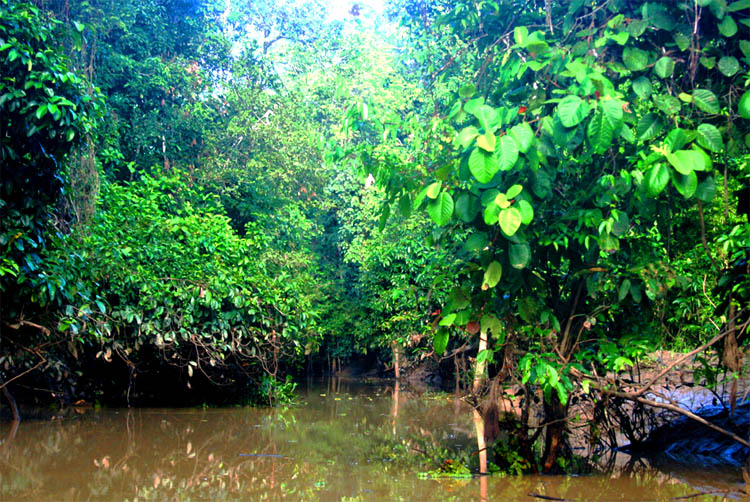
| the Kinabatangan River
|
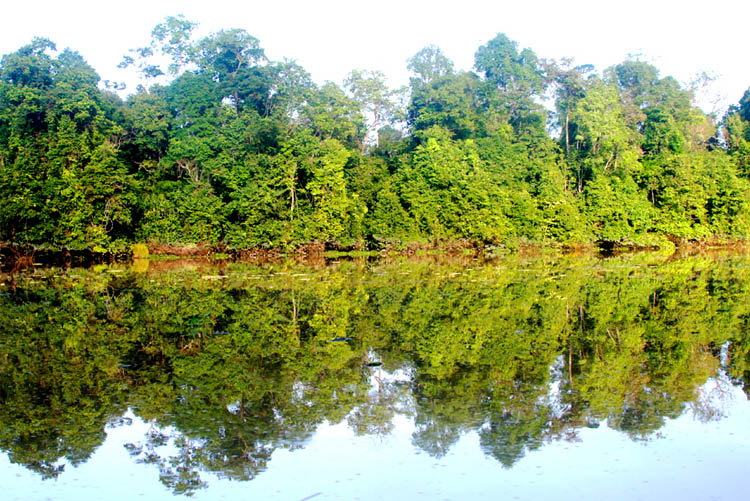
| Reaching the Oxbow Lake
|

| But water-hyacinths spoiling it a little
|
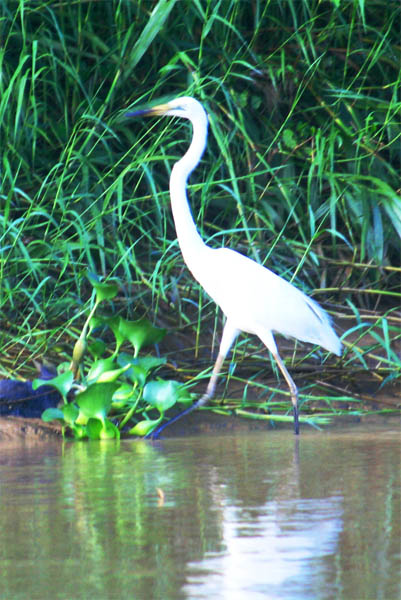
| The egrit bird does not care
|
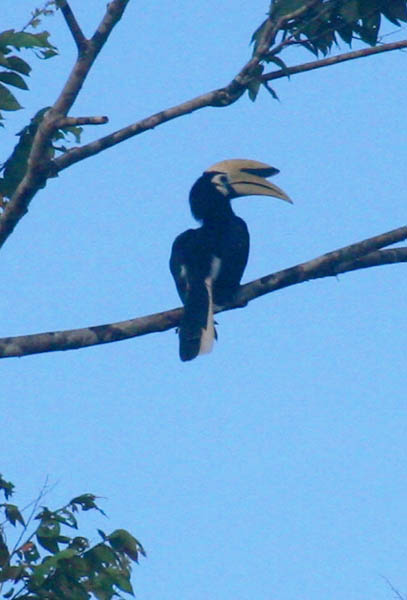
| Also the hornbill can fly away
|
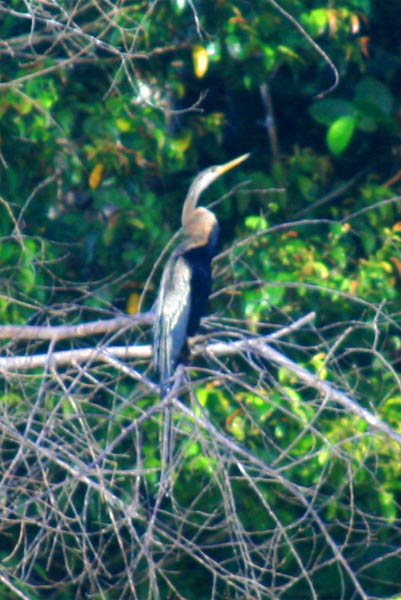
| What a beautiful bird
|
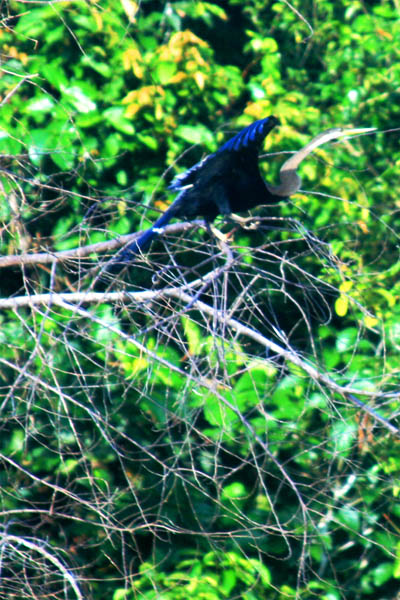
| It's the darter or snakebird
|
After around two hours of viewing the greens with wildlife we headed back to our "Sukau Greenview". After a delicious breakfast we still had some time before being picked up by our driver. It just happened that there was a Sunday market going on in the village of Sukau. So we took a look around. But we were not able to eat anything anymore, definitely neither hamburgers nor spaghetti.
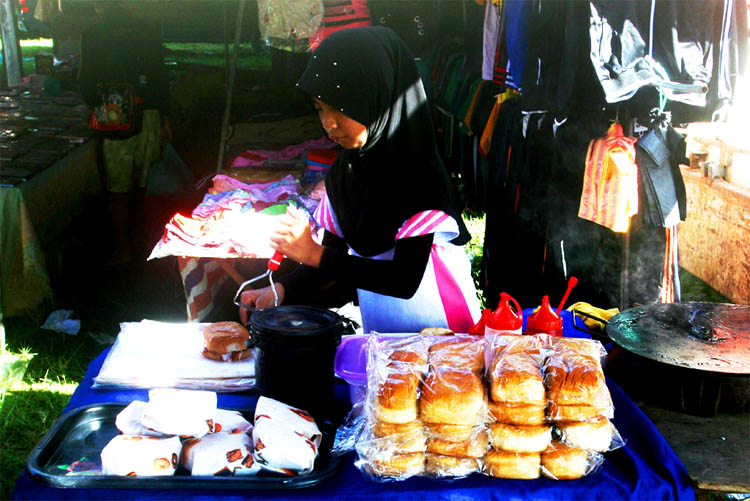
| Cooking women are busy
|
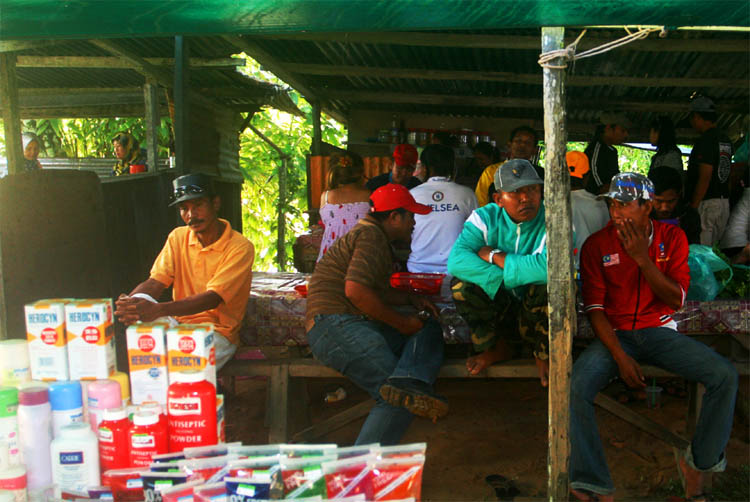
| Men don't have much to do
|
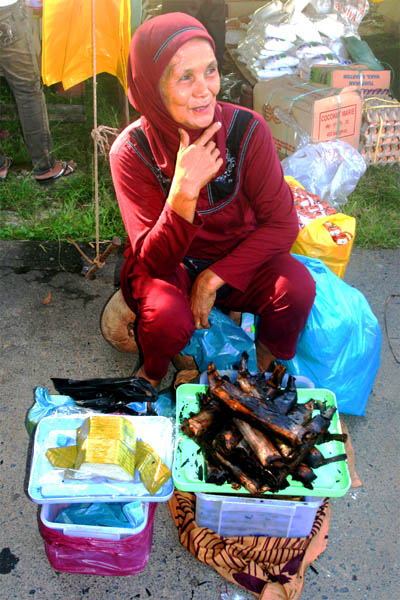
| Native food is becoming scarce but keeps you slim
|
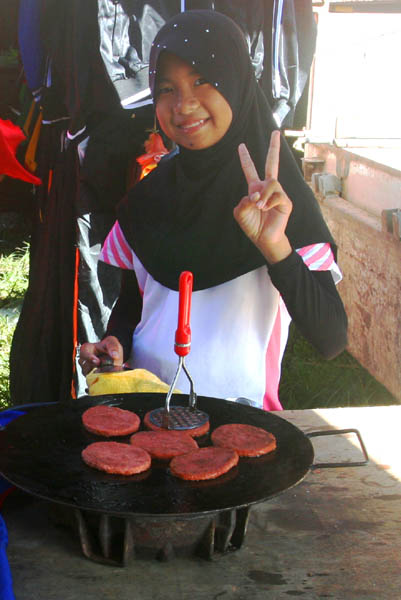
| But American hamburgers makes you obese
|
Ok, that was part I. If you want to skip now to the next part, then just hit
Part II
| 



















































































































